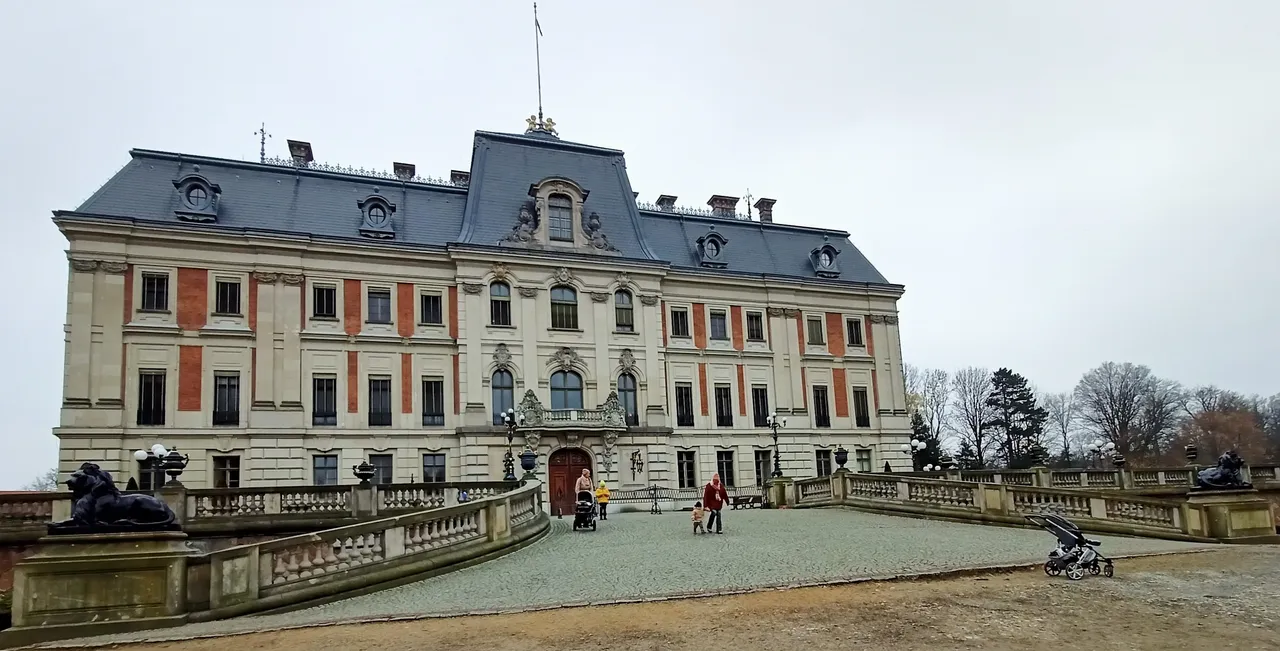
(strona także w języku PL/ENG/FR/DE )
(site also exists in PL/ENG/FR/DE)
Location info : [/Zamek Pszczyna (Castle in Pszczyna)/]:# (!pinmapple 49.978124 lat 18.940458 long d3scr)

Podstawowe informacje:
Języki:
Kompleks zamkowy , wszystkie eksponaty , opisy miejsc, przedmiotów, strona www kompleksu itd. - są dostępne w przynajmniej 3 językach:
- polski
- angielski
- niemiecki
Dojazd i Parking:
Dojazd samochodem jest prosty, wpisujemy w nawigację frazę "Muzeum Zamkowe Pszczyna".
Parking - nie ma oficjalnego parkingu. Natomiast 300-400 metrów przed celem (w nawigacji) obok drogi jest mnóstwo prywatnych parkingów (płatnych). W dni powszednie - poza sezonem turystycznym - można szukać parkingów centrum miasta - niedaleko rynku. (płatne strefy parkowania)
Dojazd autobusem/pociągiem - Dojeżdżamy do Dworca PKP/BUS , a później można pieszo bądź taksówką dojechać. Pszczyna to małe miasto (25 000 mieszkańców), a kompleks Zamkowy jest w samym centrum miasta - Na rynku. Co stanowi główna atrakcję turystyczną całego regionu.
Czas zwiedzania (Wnętrza + Zbrojownia ):
- 1 godzina => bez przewodnika
- 2 godziny => z przewodnikiem (AUDIO lub "ludzkim")
Muzeum nieczynne jest w :
- cały Grudzień i Styczeń
- poniedziałki
- święta narodowe (np. 1 Listopada oraz 11 listopada itd.)
Muzeum jest otwarte:
- wtorek - piątek => 10 - 16
- sobota - niedziela => 10 - 17
CENY:
- Bilet Normalny Wnętrza 20 zł/os ( ~ 4,50 Euro)
- Bilet Normalny Zbrojownia 6 zł/os ( ~ 1,5 Euro)
- Audio Przewodnik 10 zł ( ~2 Euro) {dostępny w języku PL/ENG/DE/FR}
Wszystkie bilety można nabyć online
P.S. Czasem (kilka razy w roku) w zamku organizowane są koncerty muzyki klasycznej (szczegóły strona www)
Basic information:
Languages:
The castle complex, all exhibits, descriptions of places, objects, website of the complex, etc. - are available in at least 3 languages::
Directions & Parking:
Getting there by car is easy, type the phrase "Pszczyna Castle Museum" into the navigation.
Parking - there is no official parking lot. However, 300-400 meters before the destination (in the navigation) next to the road there are plenty of private parking lots (paid). On weekdays - out of tourist season - you can look for parking downtown - near the market square. (paid parking zones)
By bus/train - Get to the train/bus station and then you can walk or take a cab. Pszczyna is a small town (25 000 inhabitants) and the castle complex is in the very center of the town - on the market square. What is the main tourist attraction of the whole region.
Sightseeing time (Interior + Armory ):
- 1 hour => no guide
- 2 hours => with guide (AUDIO or "human")
The museum is closed on :
- All December and January
- Mondays
- National holidays (e.g., Nov. 1, Nov. 11, etc.)
The museum is open:
- Tuesday - Friday => 10 am - 4 pm
- Saturday - Sunday => 10 am - 5 pm
PRICES:
- Normal Ticket Interior 20 PLN/person ( ~ 4.50 Euro)
- Normal Ticket Zbrojownia 6 zł/os ( ~ 1,5 Euro)
- Audio Guide 10 PLN ( ~2 Euros) {language available PL/ENG/DE/FR}
All tickets can be purchased online
P.S. Sometimes (several times a year) there are classical music concerts organized in the castle (details on the website)

I. Krótki "Rys Historyczny"
Zamek. Gdy słyszymy "zamek" kojarzy nam się w masywnymi budowlany, , z wieżyczkami, obiektem otoczonym fosom. Wybudowano go w XV w. Na początku wyglądał jak "typowy" zamek i pełnił funkcje obronne. Natomiast wraz z upływem czasu, obiekt został przebudowany w "Pałac Zamkowy".
Największą rozkwit kompleks przeżył w XIX.
Dzięki Książę Hans Heinrich XI, który panował na zamku (1855-1907). Z nim wiąże się obecny kształt samego zamku. W tym czasie Pszczyna odwiedzana była przez królów pruskich, niemieckich cesarzy oraz ich królewskich gości z całej Europy, a sam Hans Heinrich XI pełnił na dworze berlińskim godność cesarskiego Wielkiego Łowczego. Koniecznością więc stało się posiadanie rezydencji godnej pozycji księcia.
Natomiast sławę, prestiż i "lokalną nazwę" (Zamek Daisy) kompleks zyskał po śmierci Hans Heinrich XI. Gdy dobra pszczyńskie przejął książę Hans Heinrich XV (1861-1938). Jego żoną była słynna z urody Angielka, Mary Theresa Olivia Cornwallis-West, księżna von Pless, nazywana Daisy (1873-1943).
W czasie "urzędowania" Daisy, obiekt zyskał sławę i prestiż na skalę europejską. Z tego powodu w latach 1914-1917 zamek pszczyński , był cesarską Główną Kwaterą i siedzibą sztabu wojsk niemieckich. To właśnie w Pszczynie cesarz, szef sztabu gł. marszałek Paul von Hindenburg oraz szef sztabu wsch. generał Erich von Ludendorff podejmowali decyzje wojskowe zmieniające oblicze ówczesnej Europy.
Należy podkreślić, że w Muzeum zachowało się około 80% oryginalnego wyposażenia wnętrz z przełomu wieków XIX/XX
I. Brief "Historical Overview"
Castle. When we hear "castle" we associate it with massive buildings, with turrets, surrounded by moats. At first it looked like a "typical" castle and had defensive functions. With the passing of time, however, the object was rebuilt into a "Castle Palace".
The complex experienced its greatest boom in the 19th century.
Thanks to Prince Hans Heinrich XI, who reigned over the castle (1855-1907). The present shape of the castle itself is connected with him. At that time Pszczyna was visited by Prussian kings, German emperors and their royal guests from all over Europe, and Hans Heinrich XI himself held the dignity of Imperial Grand Hunter at the Berlin court. So it became necessary to have a residence worthy of the position of prince.
However, the fame, prestige and "local name" (Daisy Castle) the complex gained after the death of Hans Heinrich XI. When the Pszczyna estates were taken over by Prince Hans Heinrich XV (1861-1938). His wife was an Englishwoman, famous for her beauty, Mary Theresa Olivia Cornwallis-West, duchess von Pless, called Daisy (1873-1943).
During the "tenure" of the Daisy, the building gained fame and prestige on a European scale. For this reason, in the years 1914-1917, the castle in Pszczyna was the headquarters of the German army. It was in Pszczyna that the Emperor, Chief of Staff Marshal Paul von Hindenburg and Chief of Staff for the East, General Erich von Ludendorff, made military decisions that changed the face of Europe at that time.
It should be noted that the Museum retains approximately 80% of the original interior furnishings from the late nineteenth and early twentieth centuries
II. Na zewnątrz
Obiekt znajduje się w centrum miasta, na środku rynku. Wejście stanowi słynna "Brama Zamkowa", jedyna pozostałość po oryginalnym projekcie zamku z XV w. Obiekt z zewnątrz wygląda majestatycznie. Trudno uwierzyć że taki wielki kompleks znajduje się w sercu takiego małego miasta .
II. Outside
The building is located in the center of town, in the middle of the square. The entrance is the famous "Castle Gate", the only remnant of the original castle design from the 15th century. It is hard to believe that such a big complex is located in the heart of such a small town.
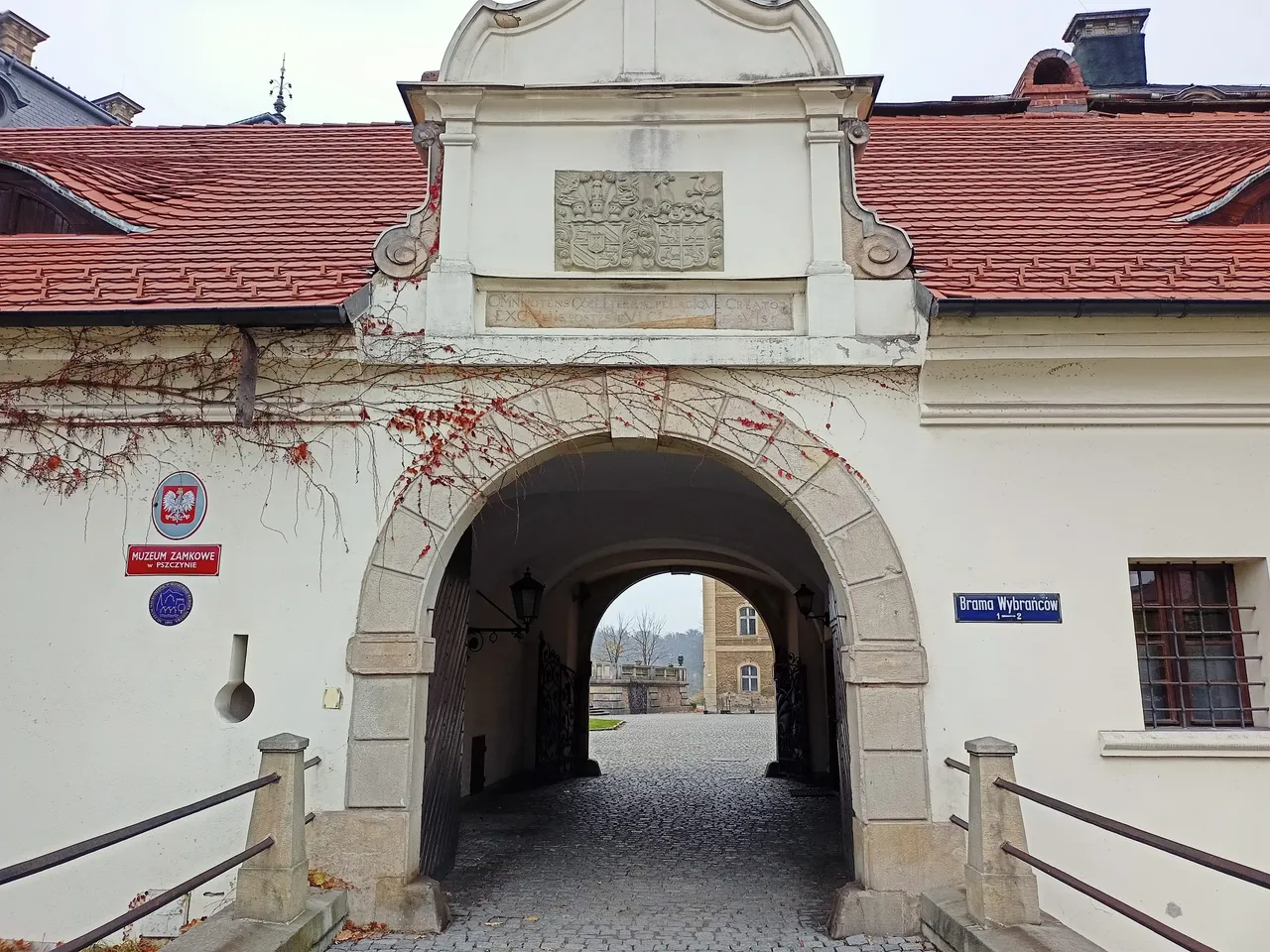 |
|---|
| The Gate - XV |
 |
|---|
| Example => Multi lingual information board |
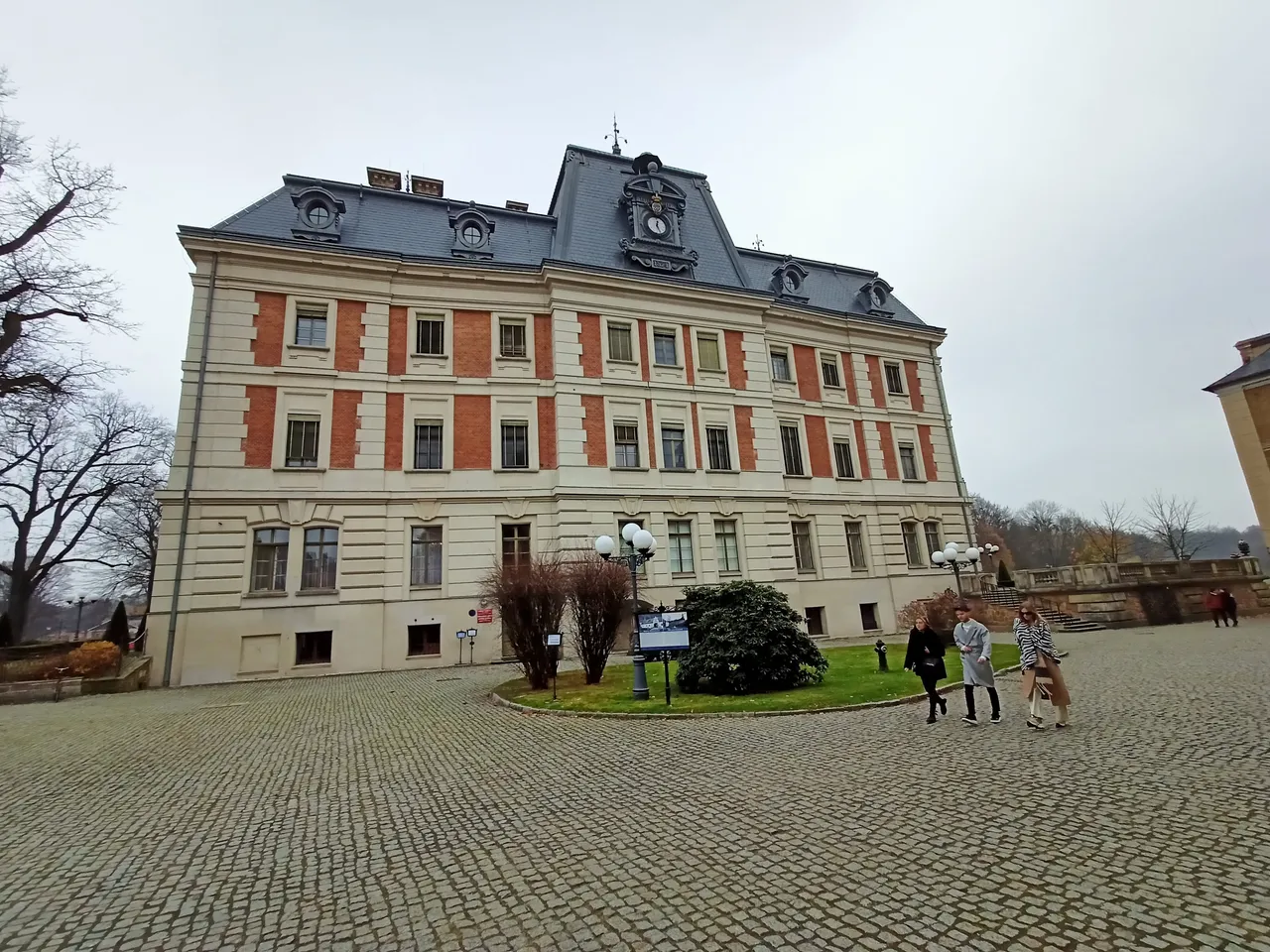 |
|---|
| Rear of the Building |
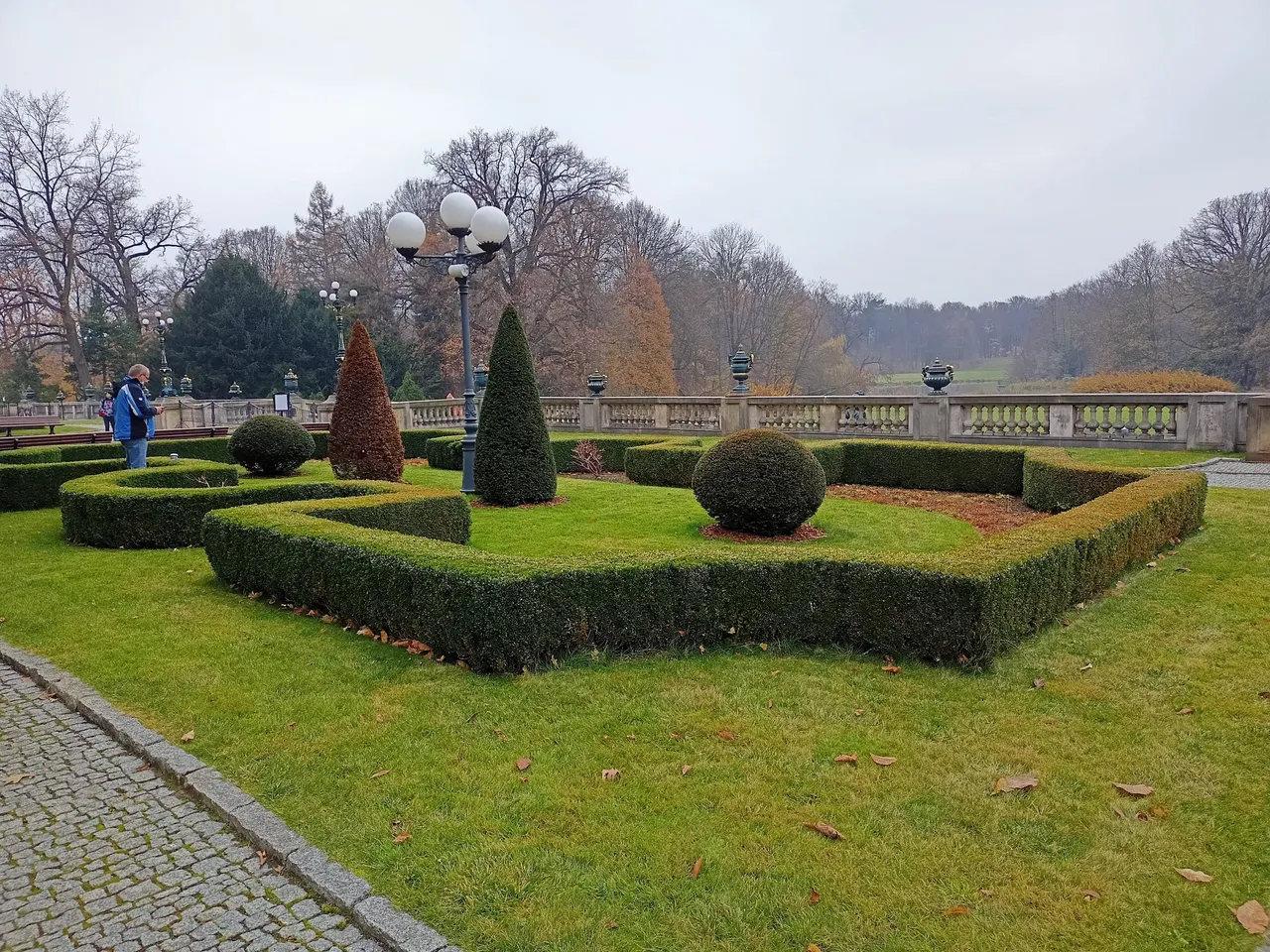 |
|---|
| Mini Gardens - just a little "taste" of "main gardens" |
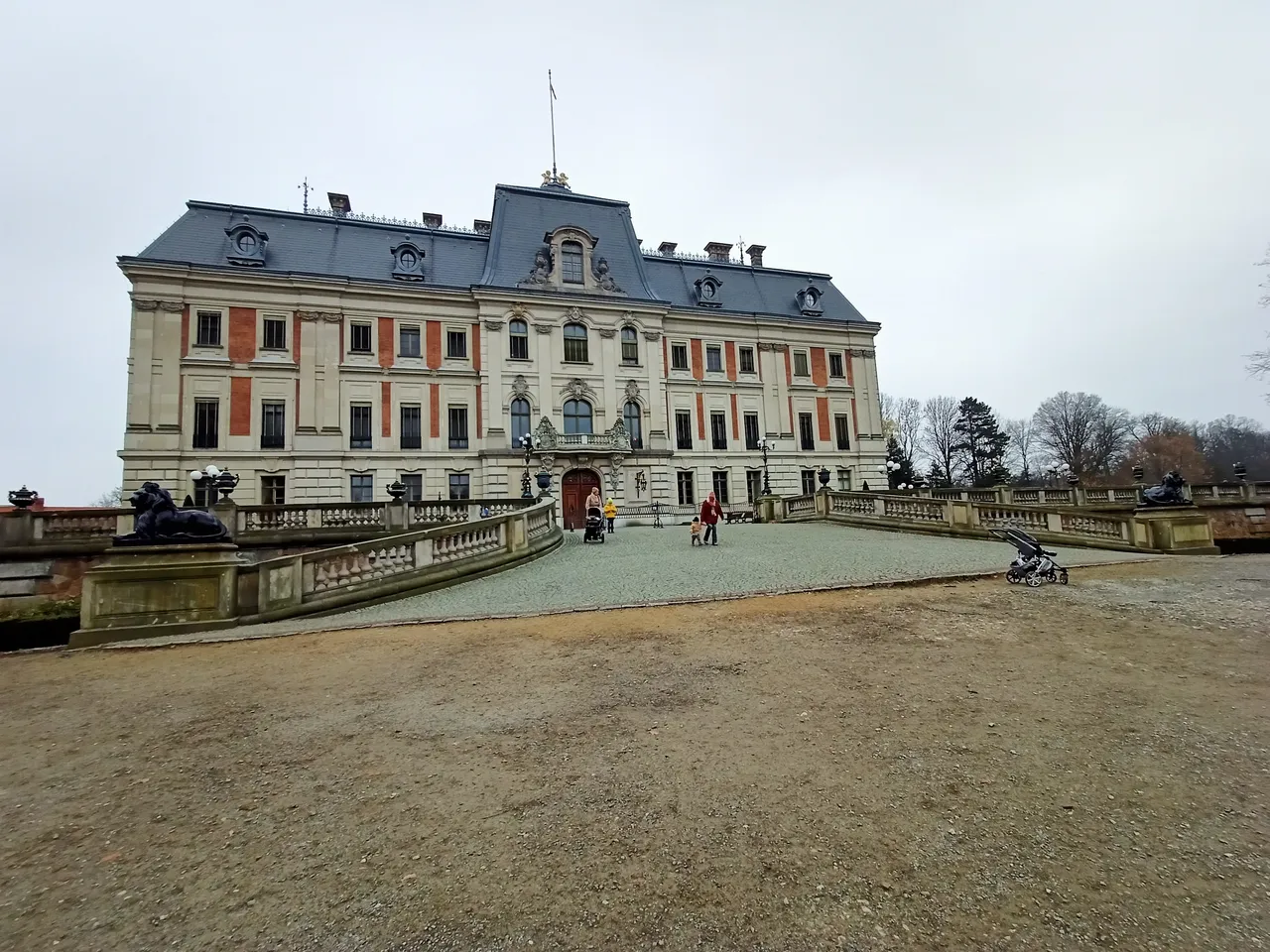 |
|---|
| Main OLD Enternance |
 |
|---|
| Magnificiant Lion |
 |
|---|
| Entry from the side |
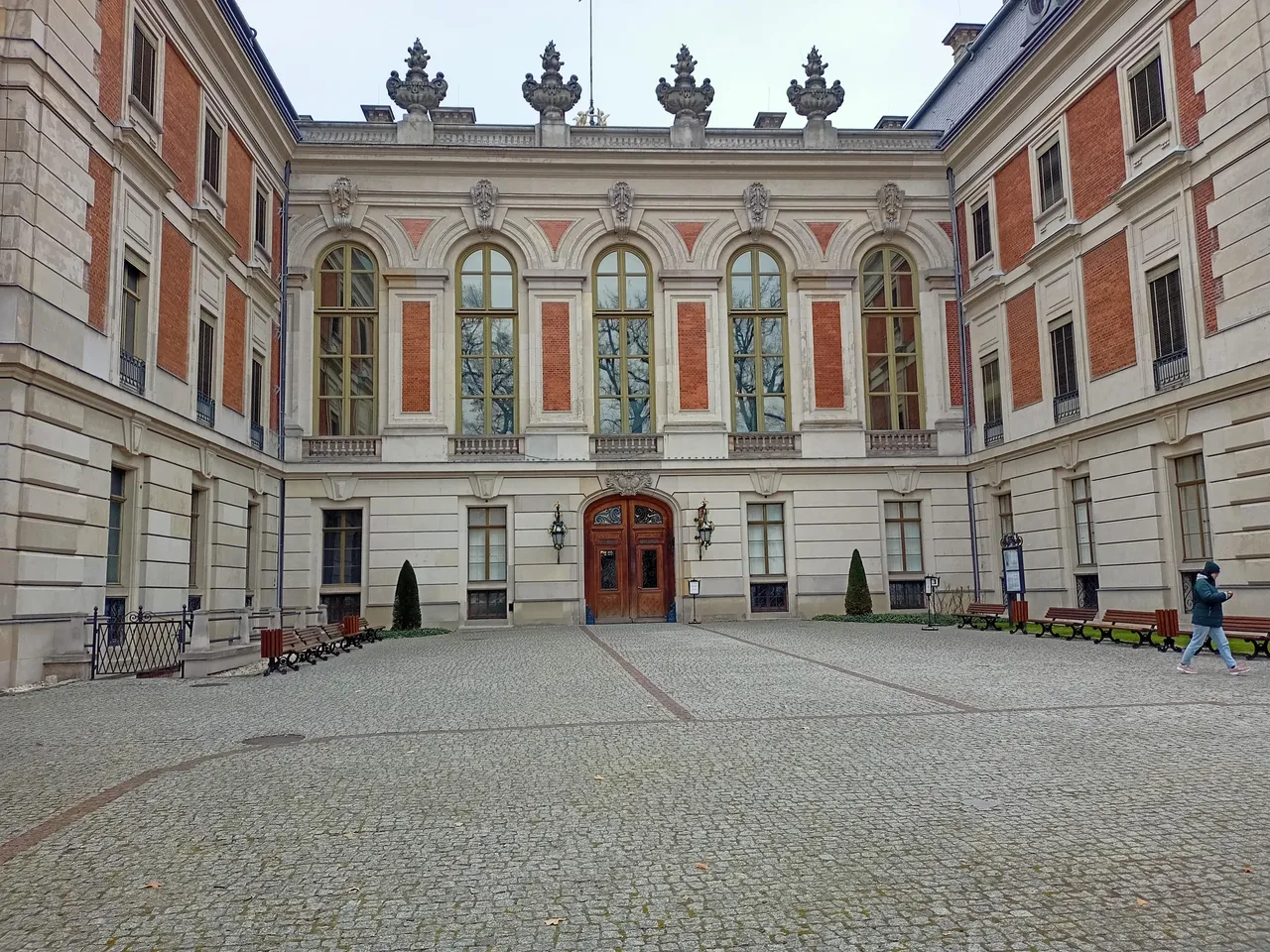 |
|---|
| The current entrance to the Museum |
III. Wnętrzna
Przepych wnętrz, majestat aż bije z każdego zakątka posiadłości. Wielkie kryształowe lustra, zdobione meble, żyrandole i wiele wiele innych eksponatów z XIX w - unikaty na skale światową. Można podziwiać jak żyła monarchia niemiecka w XIX w. Coś niezwykłego że w takiej ogromnej posiadłości mieszkało kilkoro ludzi. A dziesiątki innych ludzi - służby - dbało o dobrostan budynku i "lokatorów".
III. Interiors
The splendor and majesty of the interiors shines from every corner of the property. Large crystal mirrors, ornate furniture, chandeliers and many other exhibits from the nineteenth century - unique in the world. You can admire how the German monarchy lived in the nineteenth century. Something unusual that in such a huge estate lived a few people. And dozens of other people - servants - took care of the welfare of the building and its "tenants".
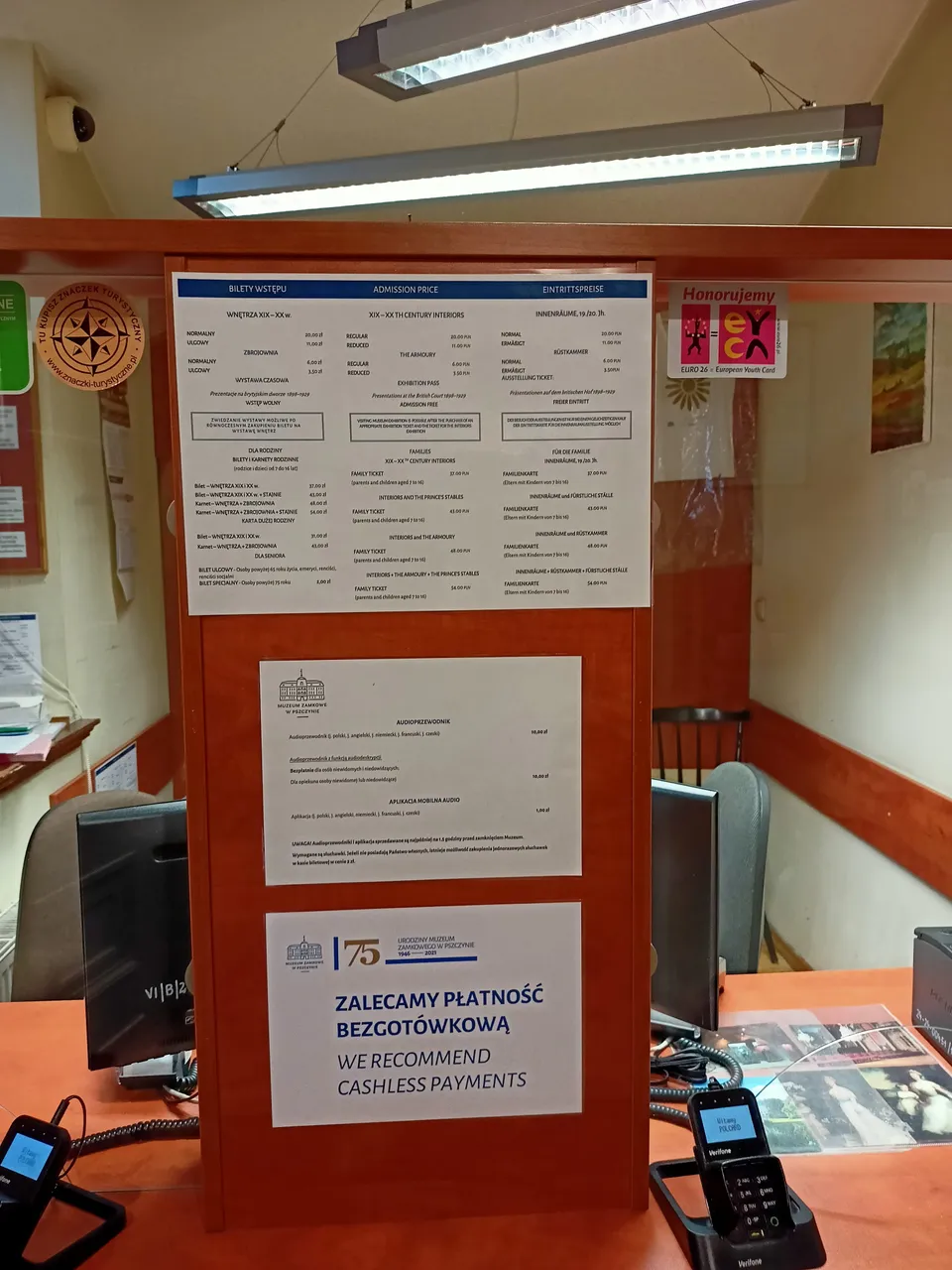 |
|---|
| Tickets & Info Point - Multi lingual |
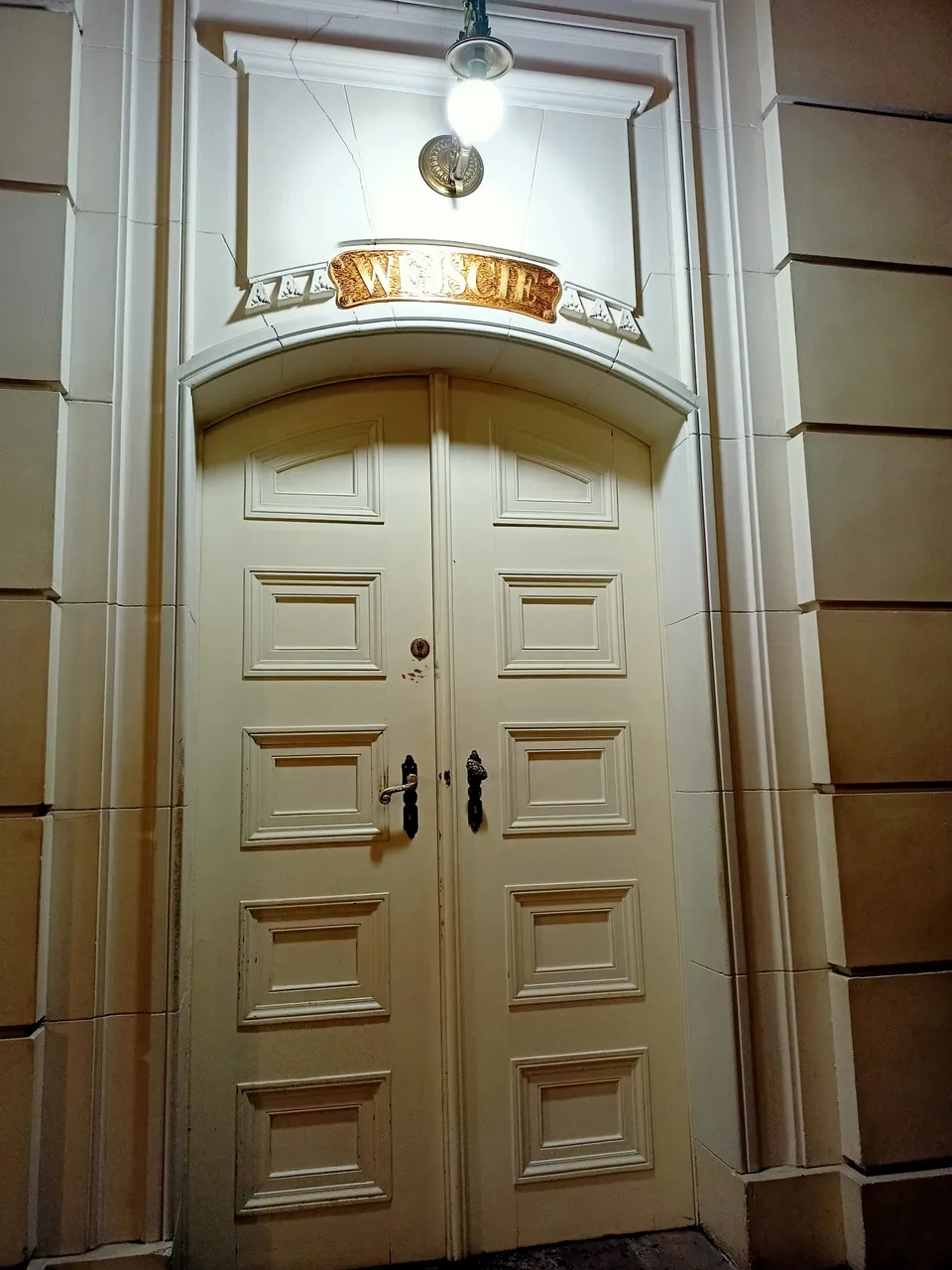 |
|---|
| Entrance |
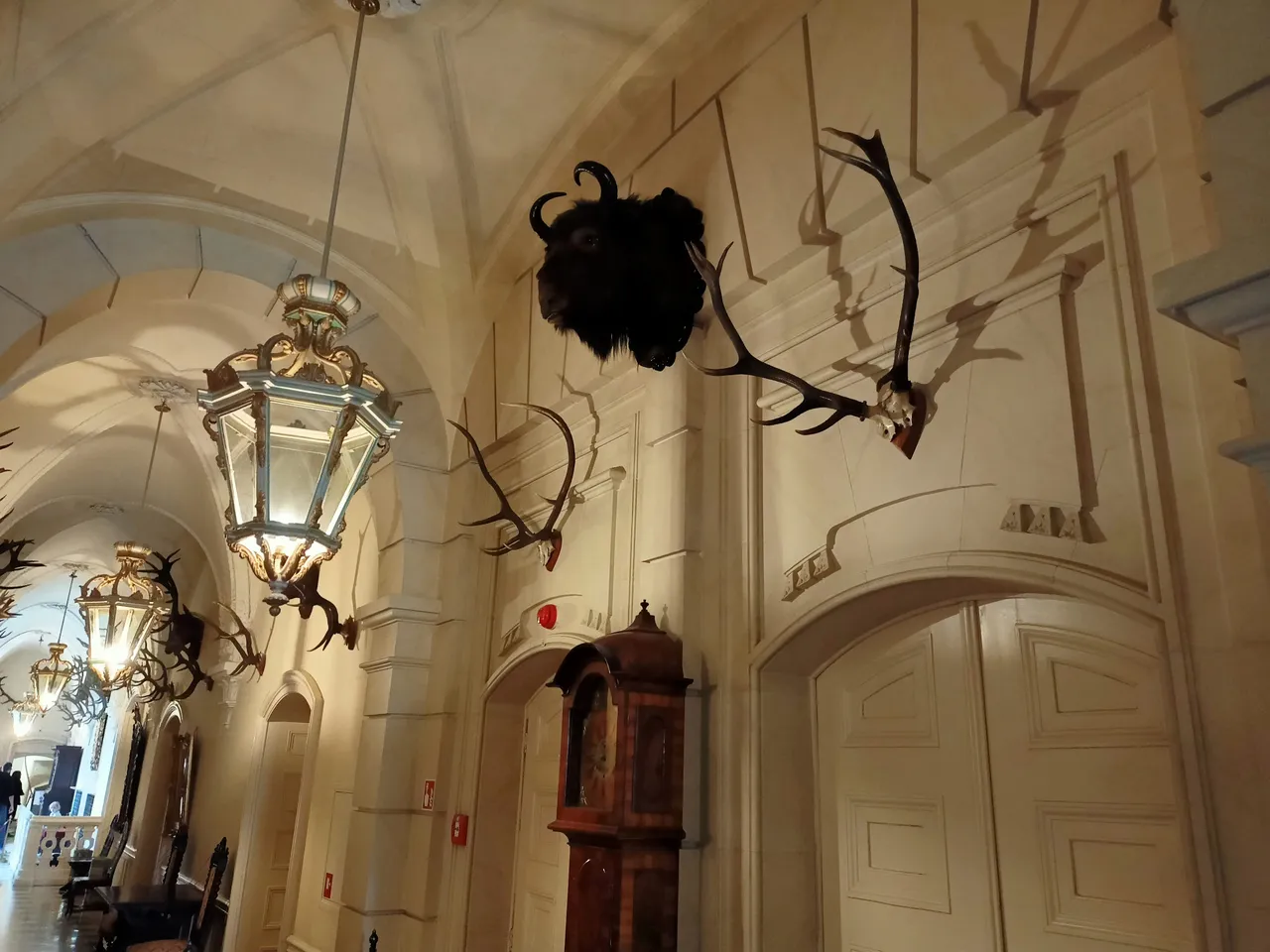 |
|---|
| Hall and some Antlers |
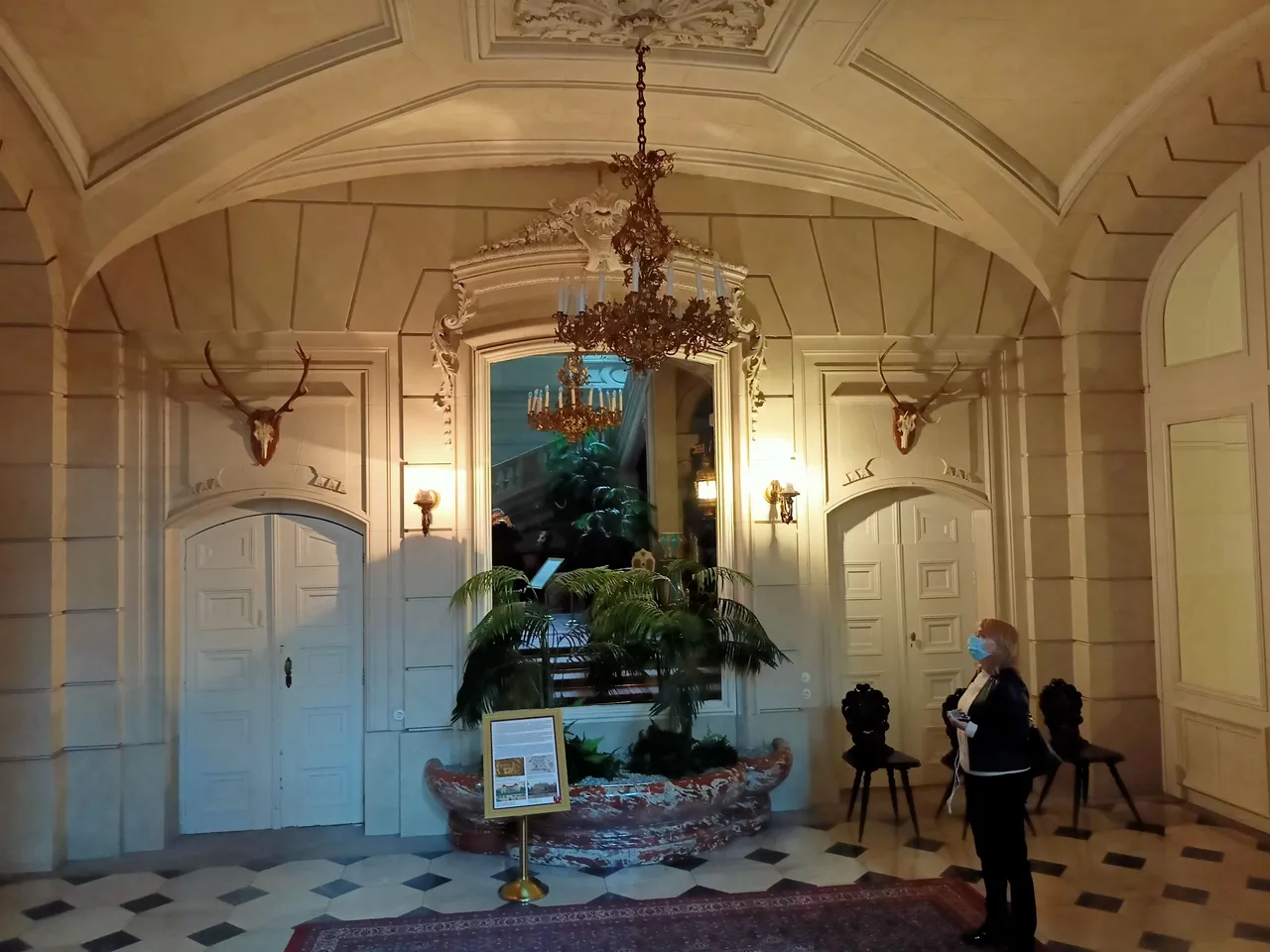 |
|---|
| Large crystal Mirror - example |
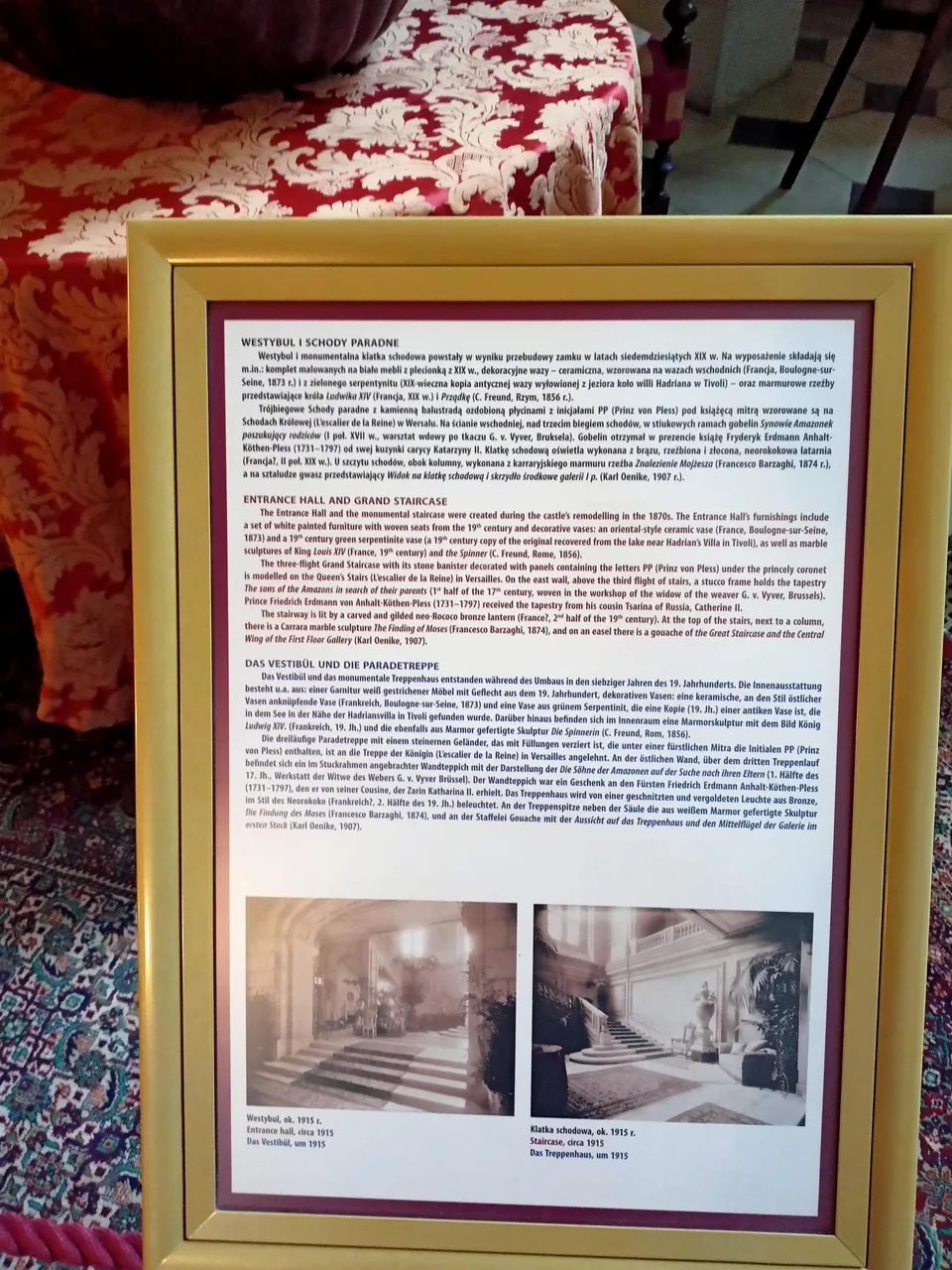 |
|---|
| Stairs - Multi Lingual Info Table - Example |
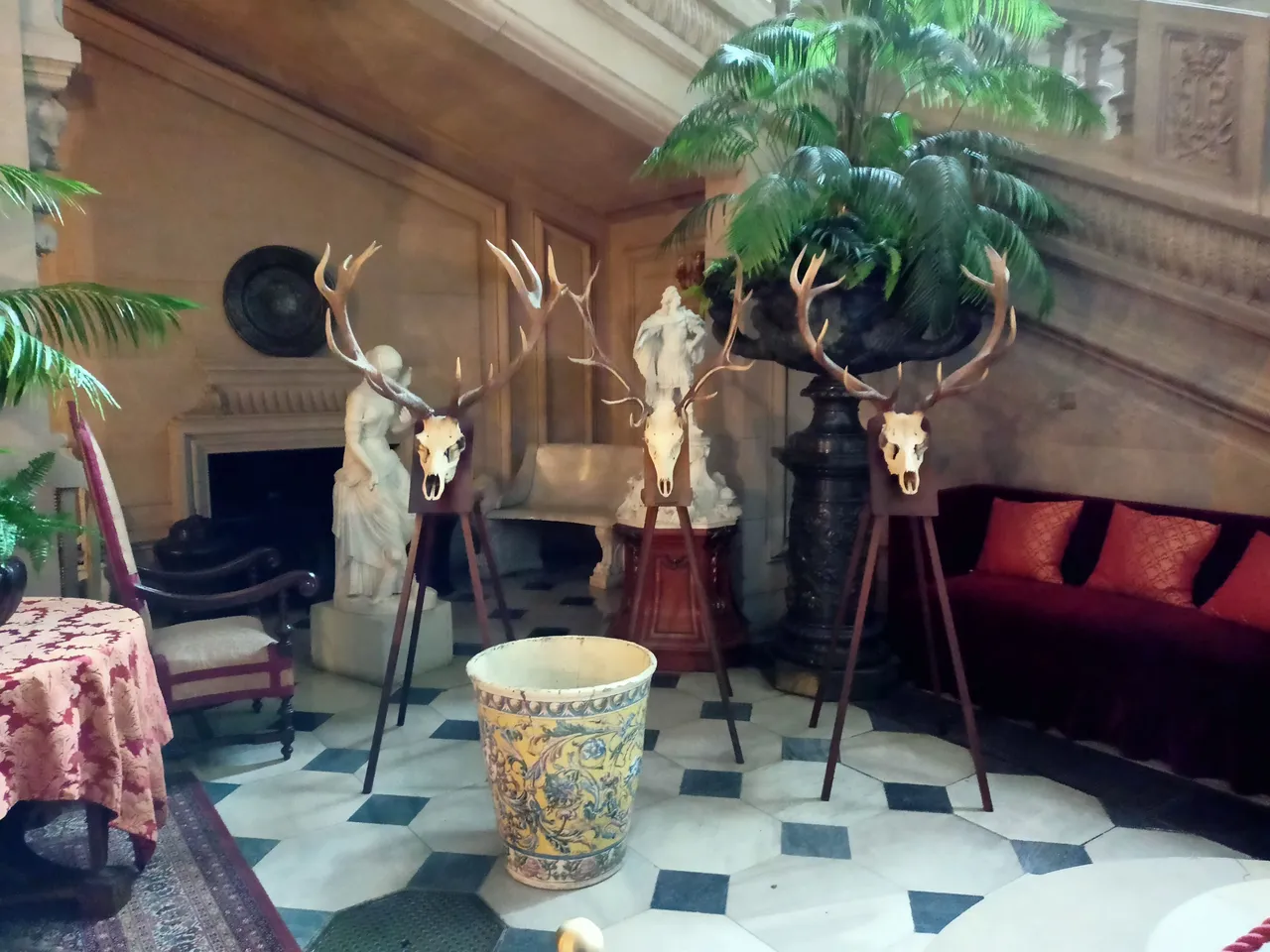 |
|---|
| more antlers by the stairs |
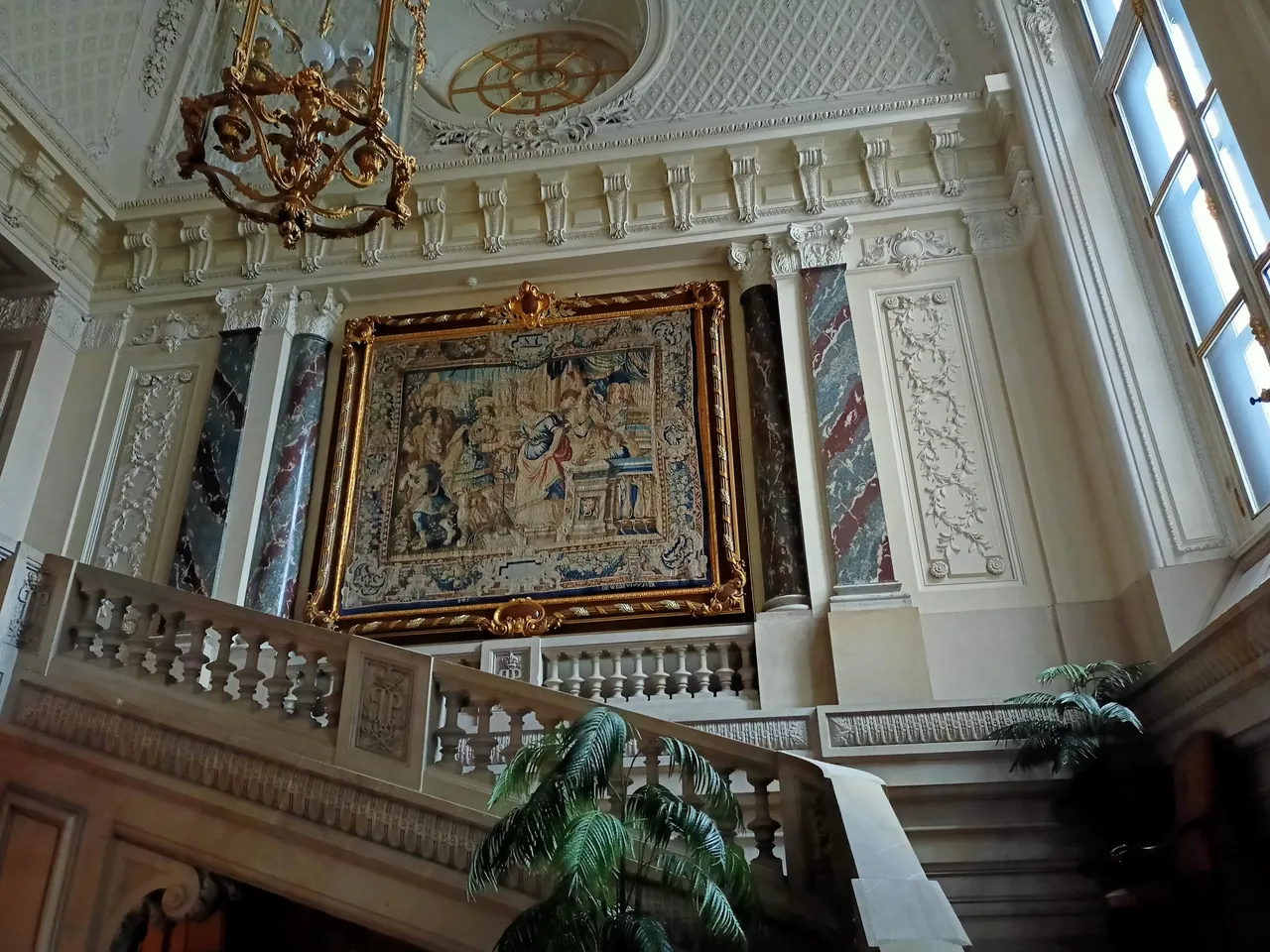 |
|---|
| staircase and beautiful decorative carpet |
 |
|---|
| room |
 |
|---|
| A lot of antlers of different animals |
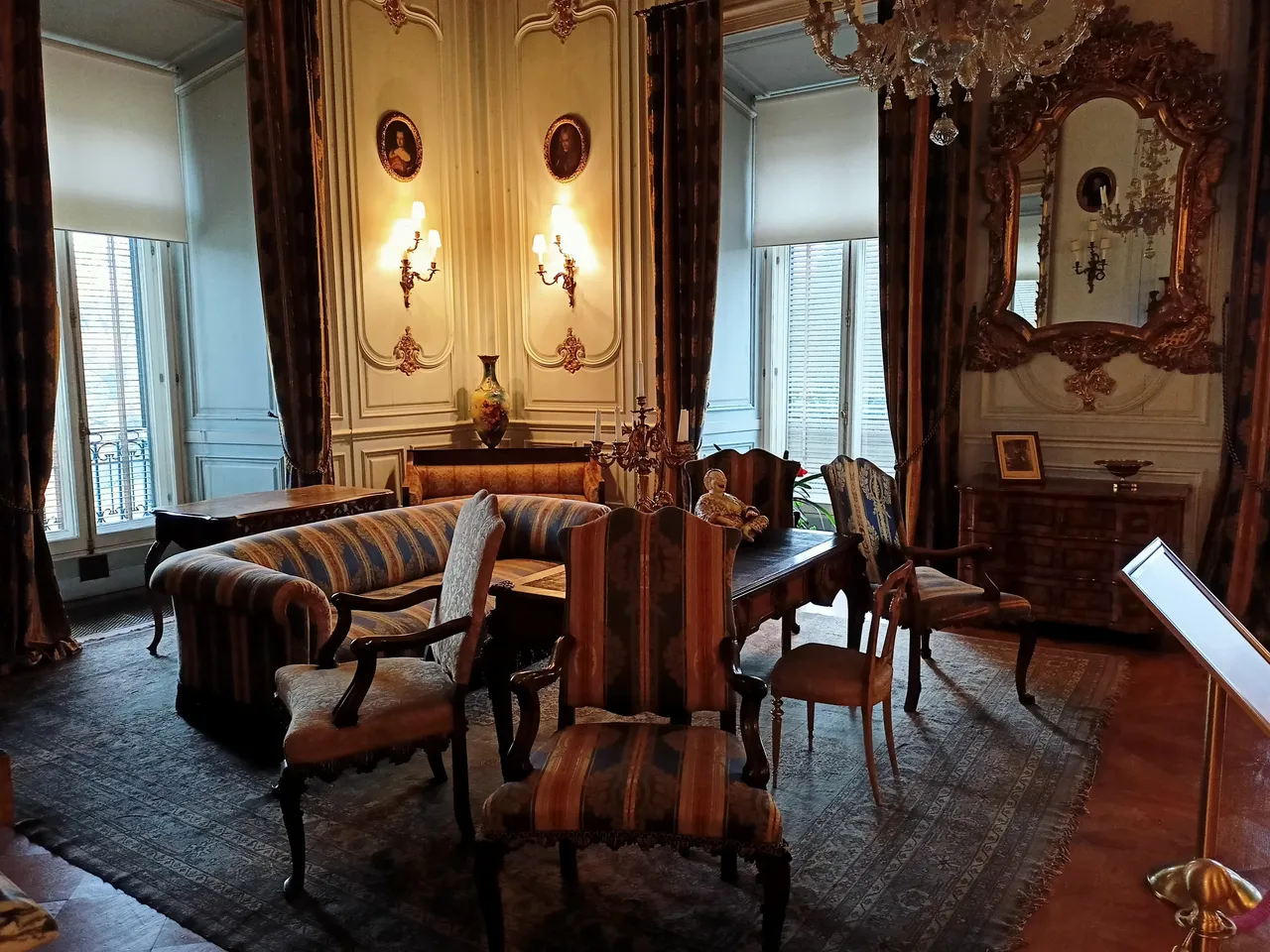 |
|---|
| some Guest room |
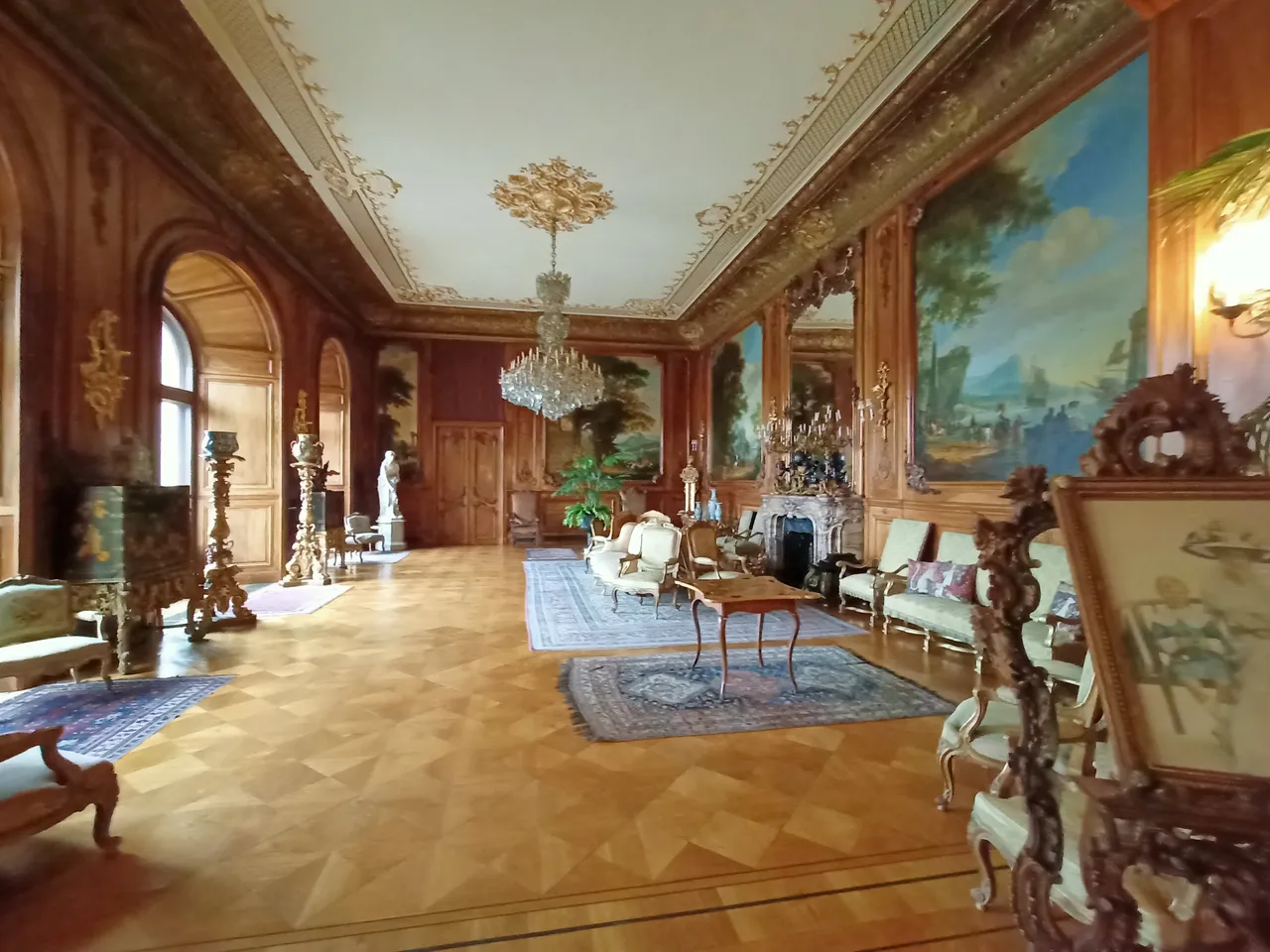 |
|---|
| living room chandelier decorations |
 |
|---|
| close-up of a beautiful candlestick |
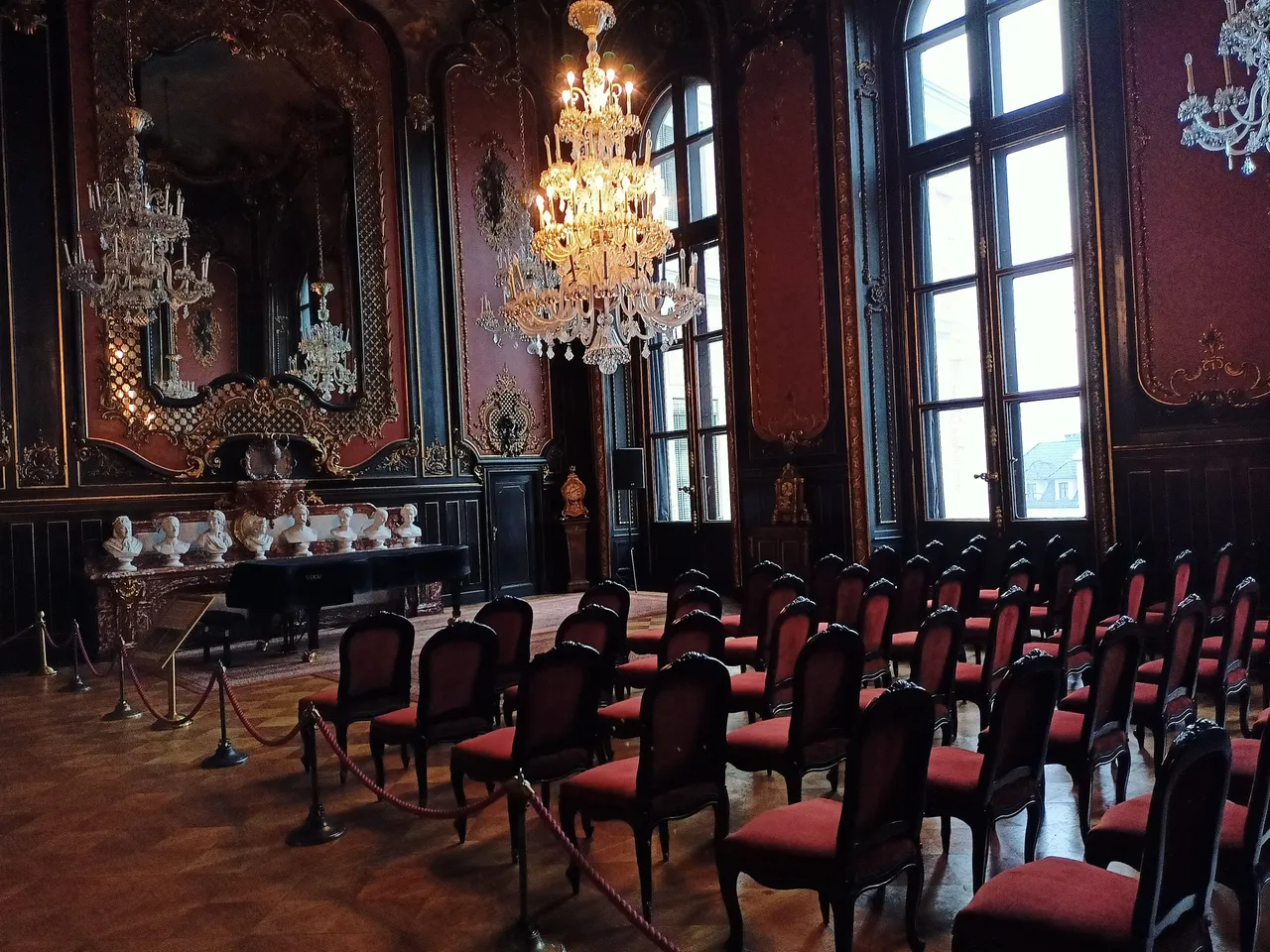 |
|---|
| concert hall |
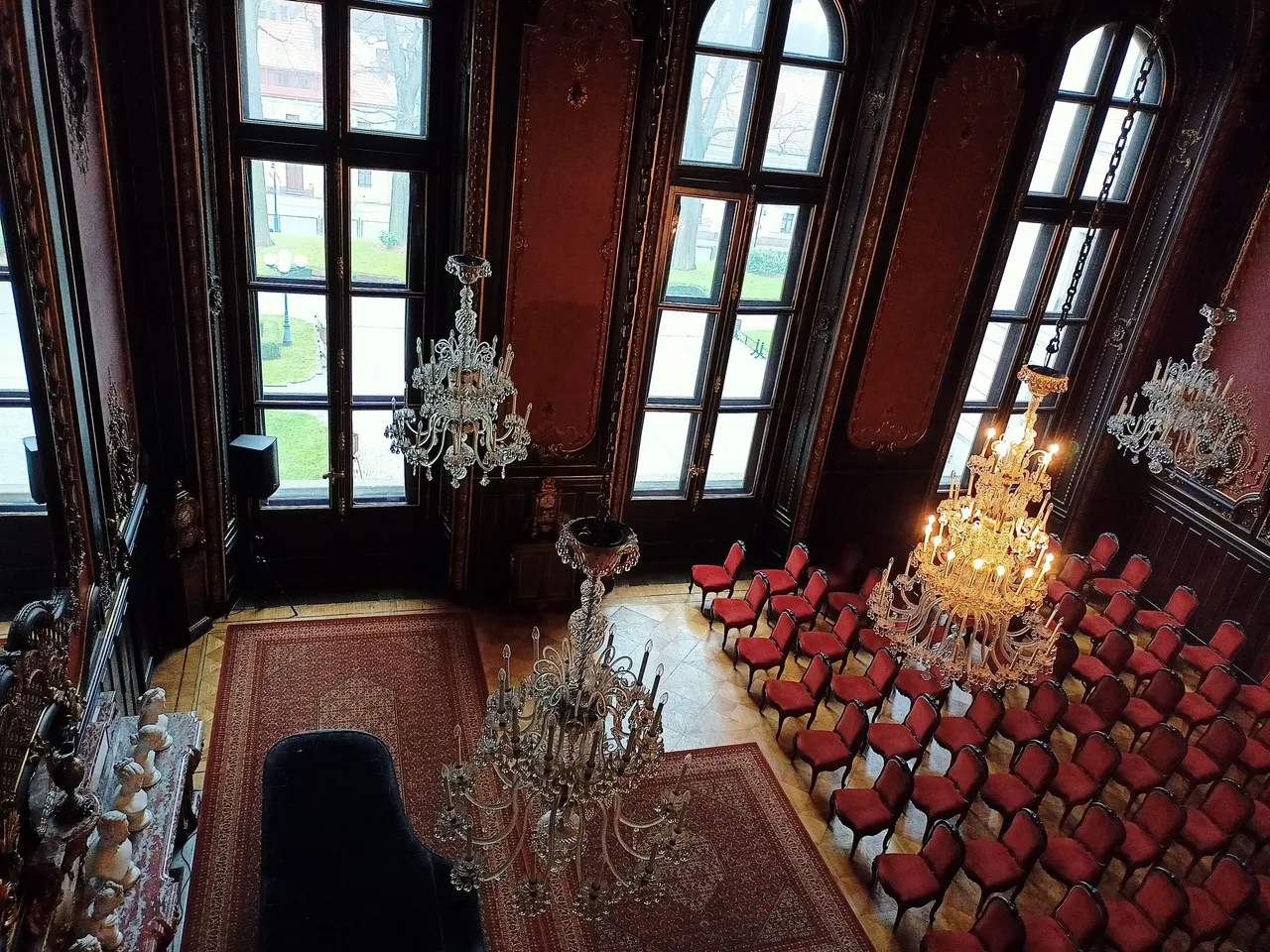 |
|---|
| concert hall - view from the balcony |
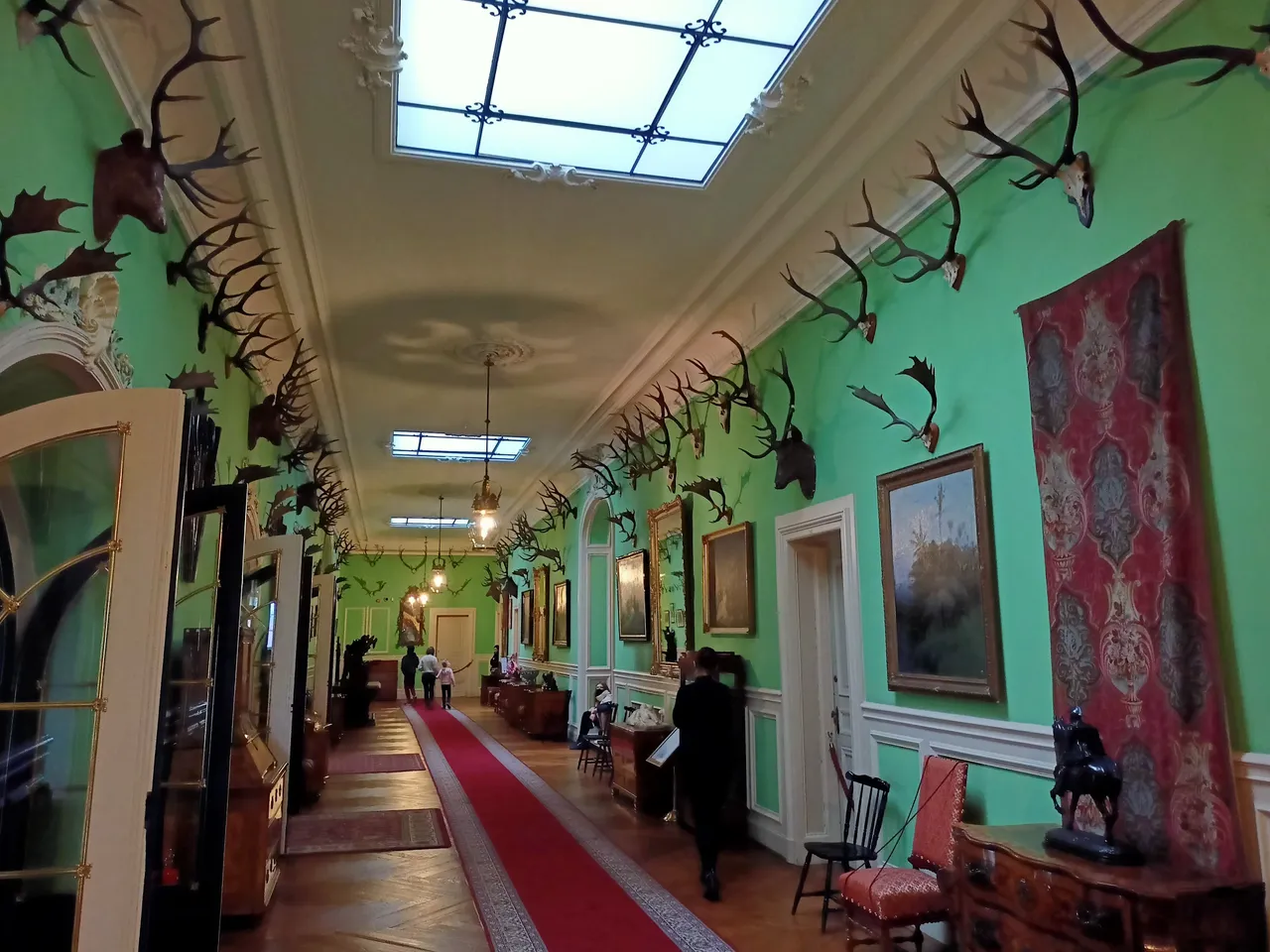 |
|---|
| 2nd floor hallway - lots of antlers |
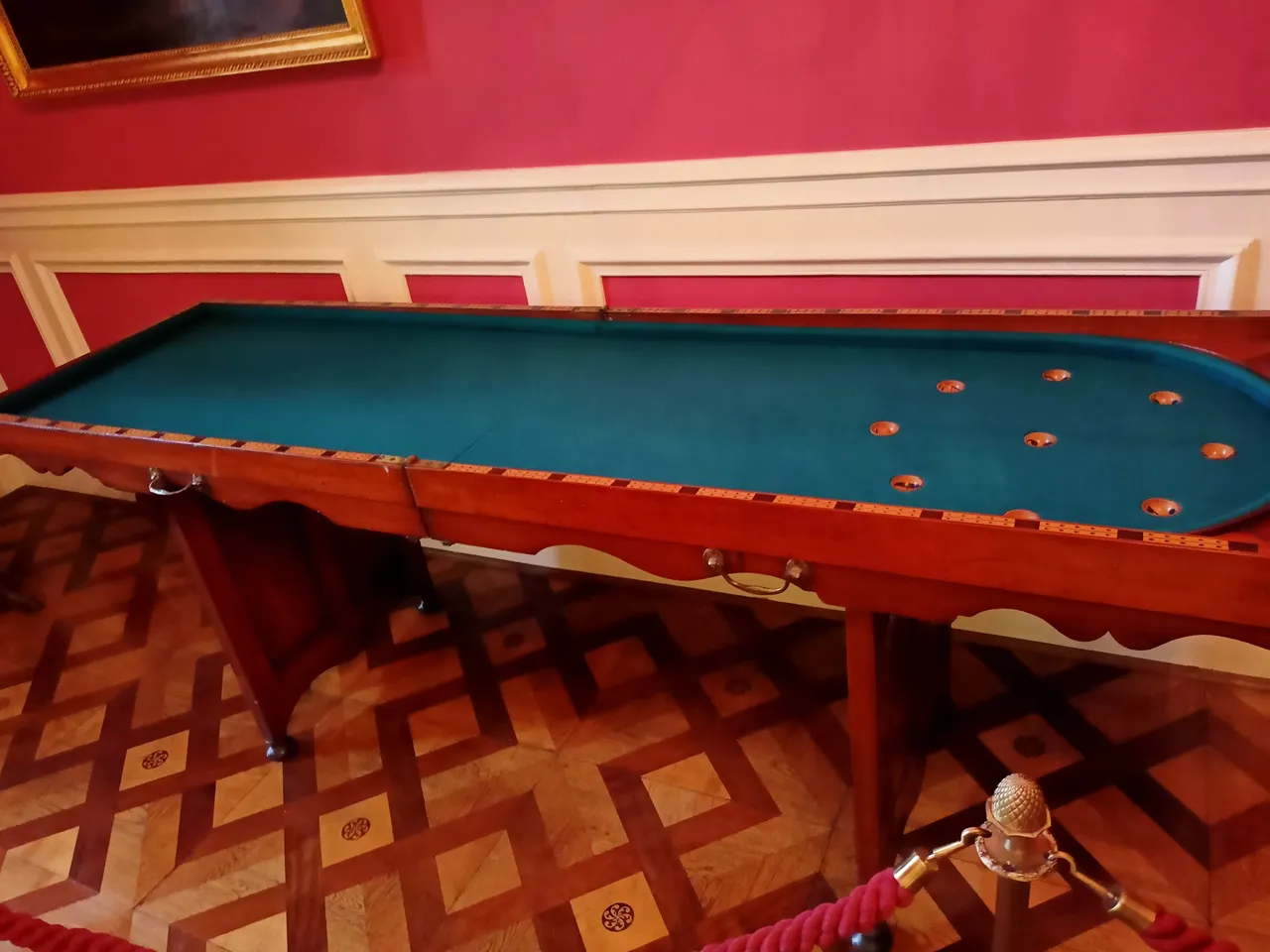 |
|---|
| game table of TROU MADAME |
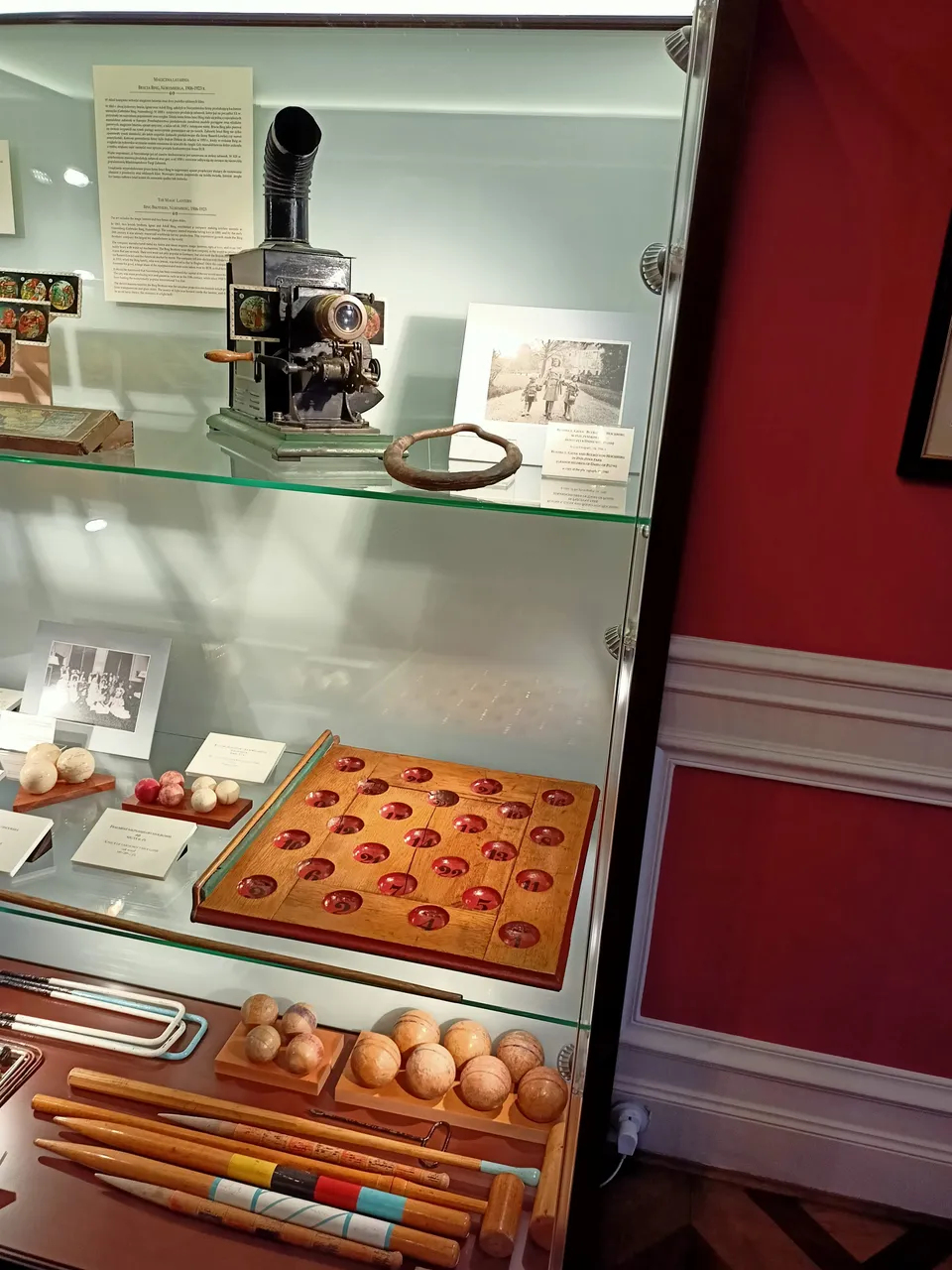 |
|---|
| Instruments to play TROU MADAME |
 |
|---|
| Some small bedroom |
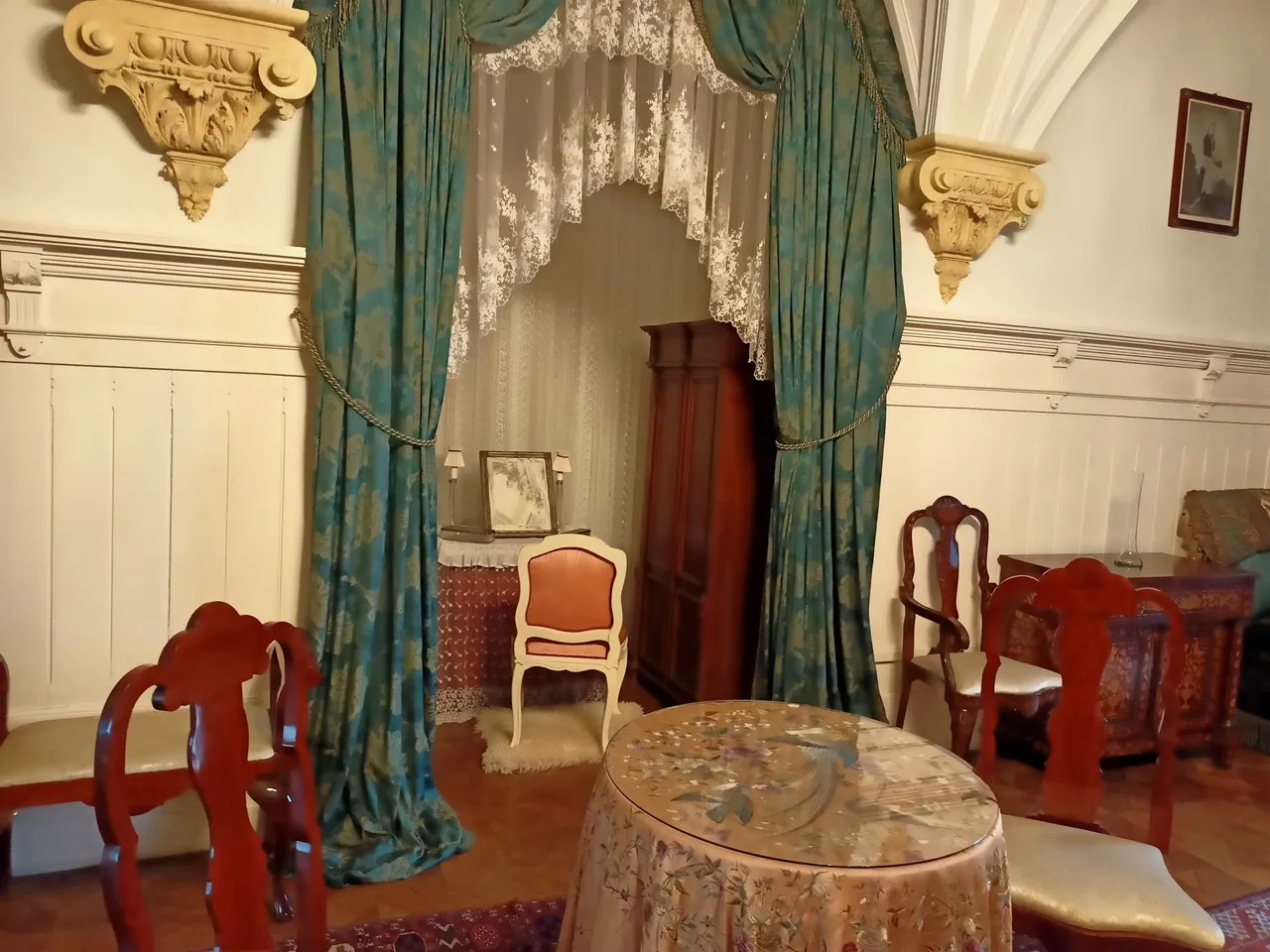 |
|---|
| bedroom furniture |
 |
|---|
| Bedroom - another view |
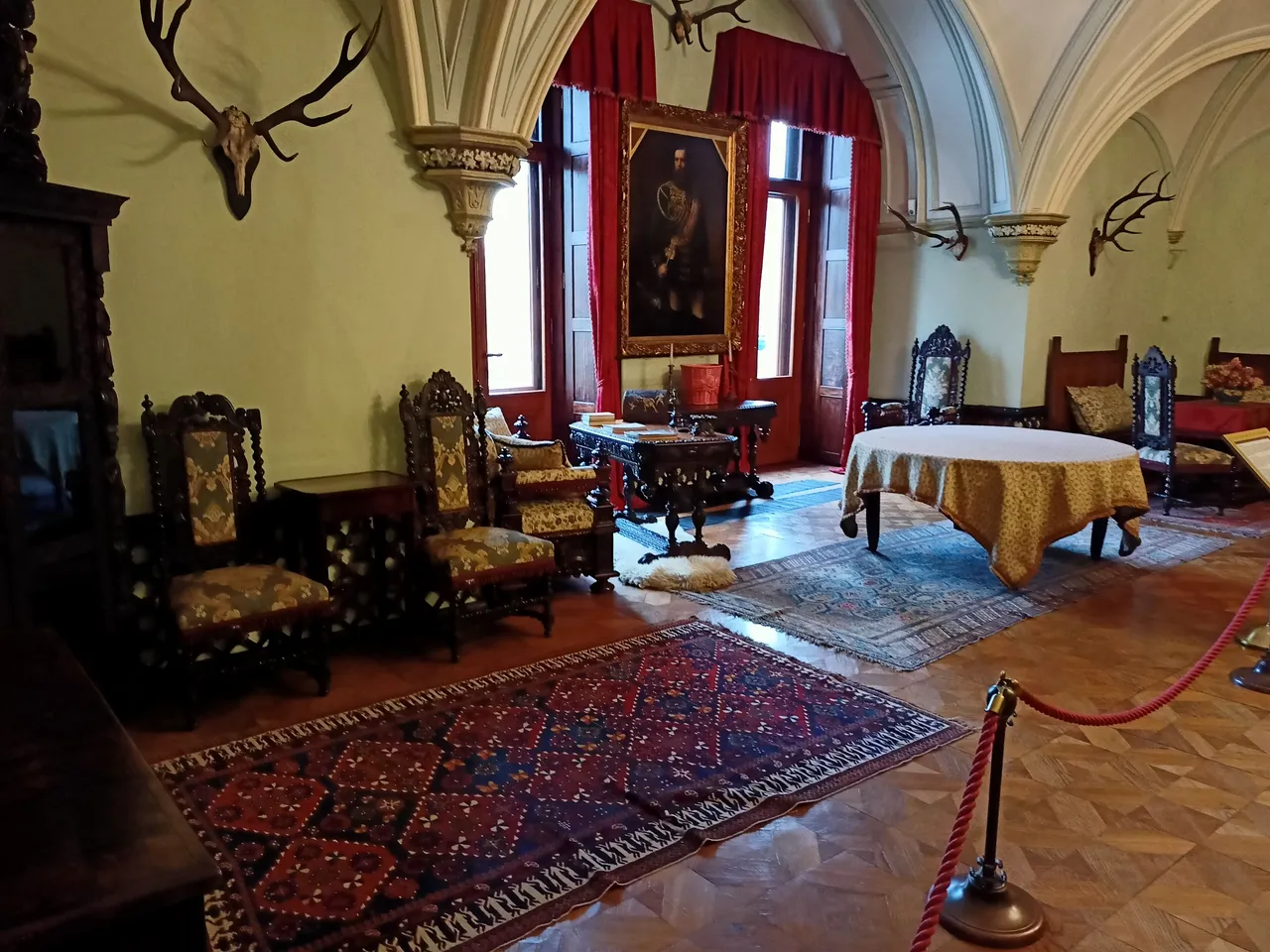 |
|---|
| CESAR OFFICE |
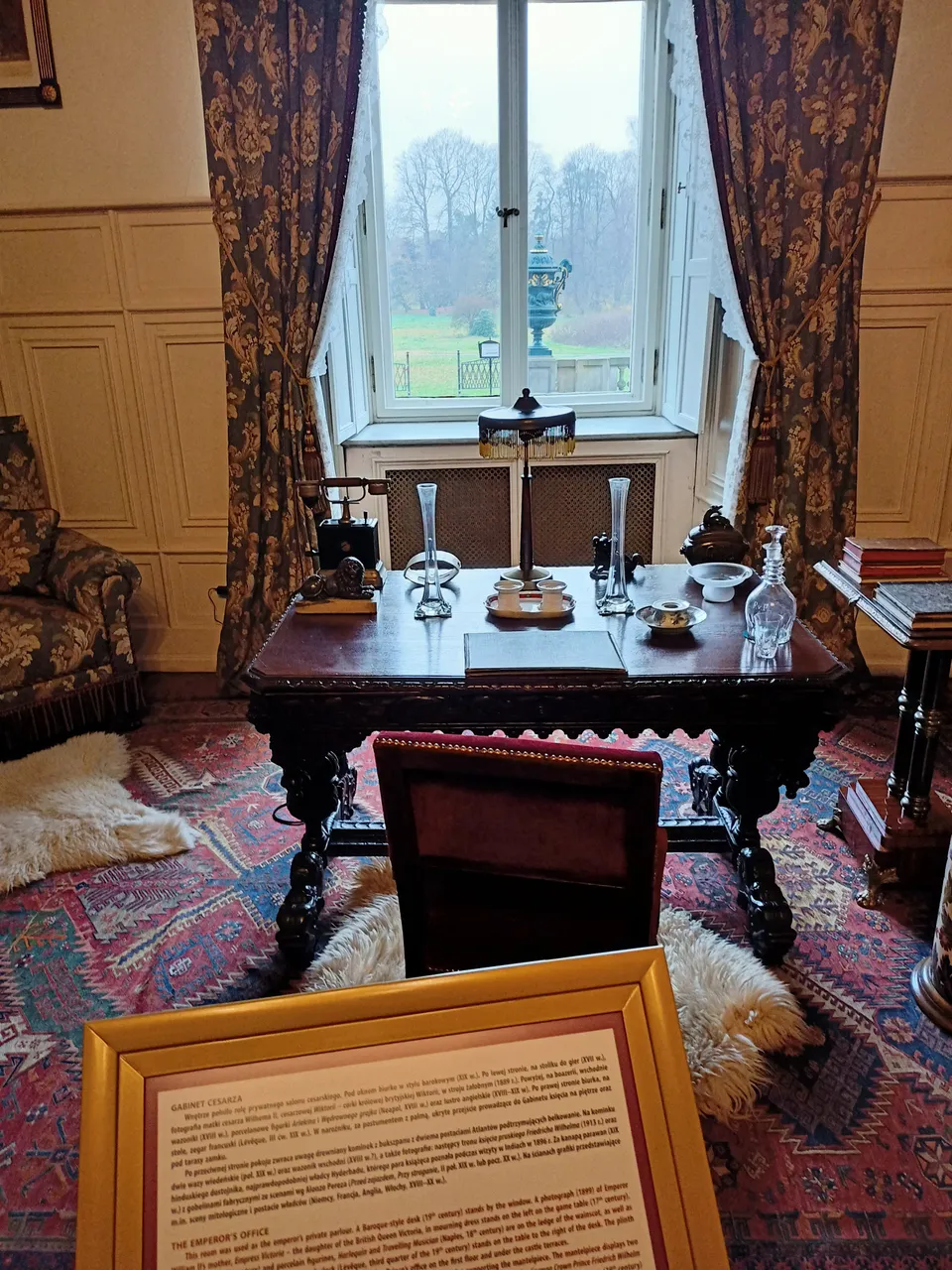 |
|---|
| The Desk of Cesar Gabinet |
 |
|---|
| CESAR BED |
IV. ZBROJOWNIA
Znajduje się tu wiele broni, używanych w XIX oraz w XX w. Różne bronie białe oraz palne. Używane głównie na polowaniach. Niektóre bronie palne ewidentnie "nie pasują" do kategorii - NA polowanie. Każdy z łatwością dostrzeże które eksponaty były używane na wojnie a które do polowania na różne zwierzęta.
IV. ARMORY
There are many weapons used in the 19th and 20th centuries. Various white weapons and firearms. Used mainly for hunting. Some of the firearms clearly "do not fit" into the category - FOR hunting. Everyone can easily see which exhibits were used in war and which were used for hunting different animals.
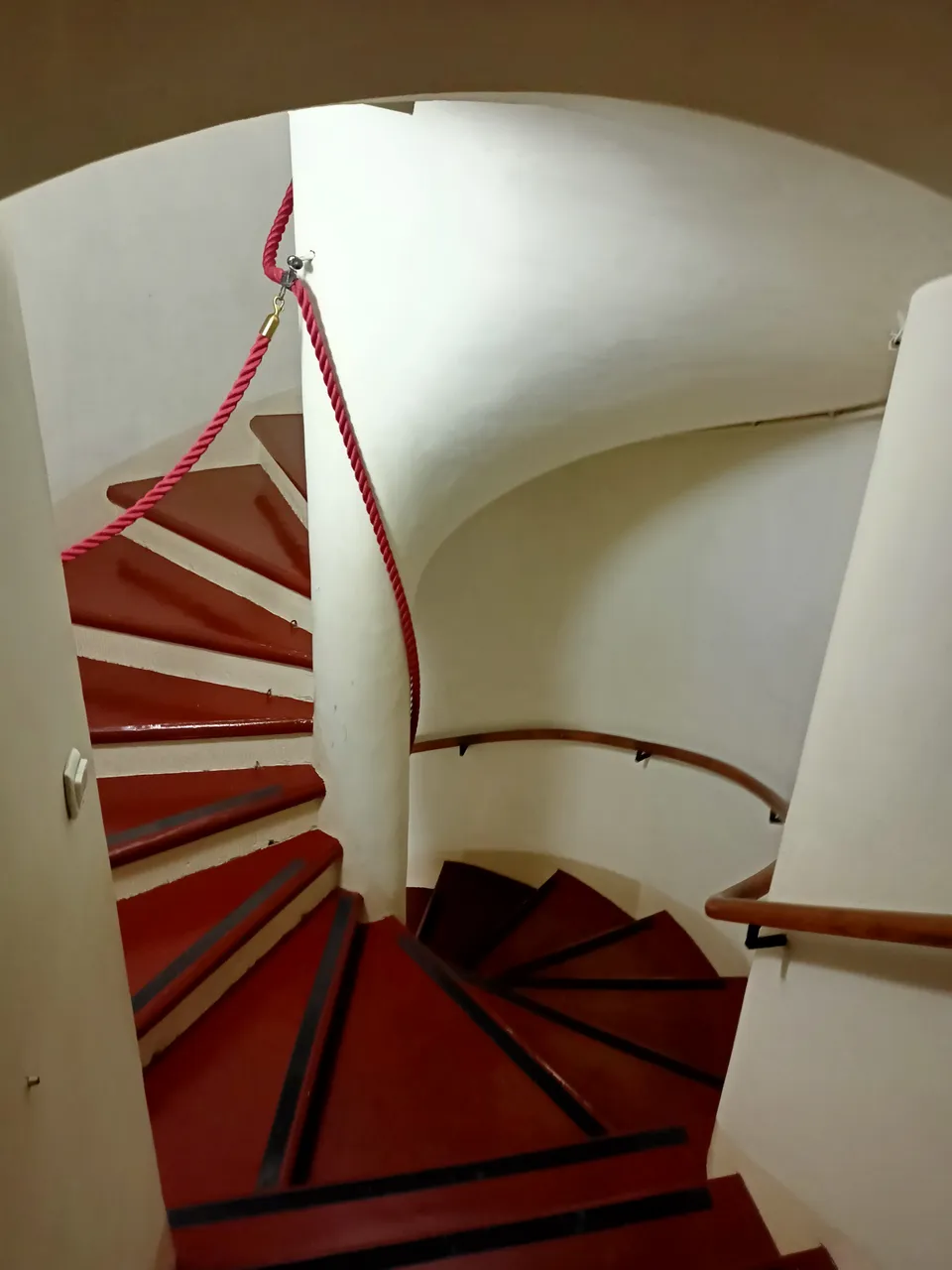 |
|---|
| Stairs to Armory |
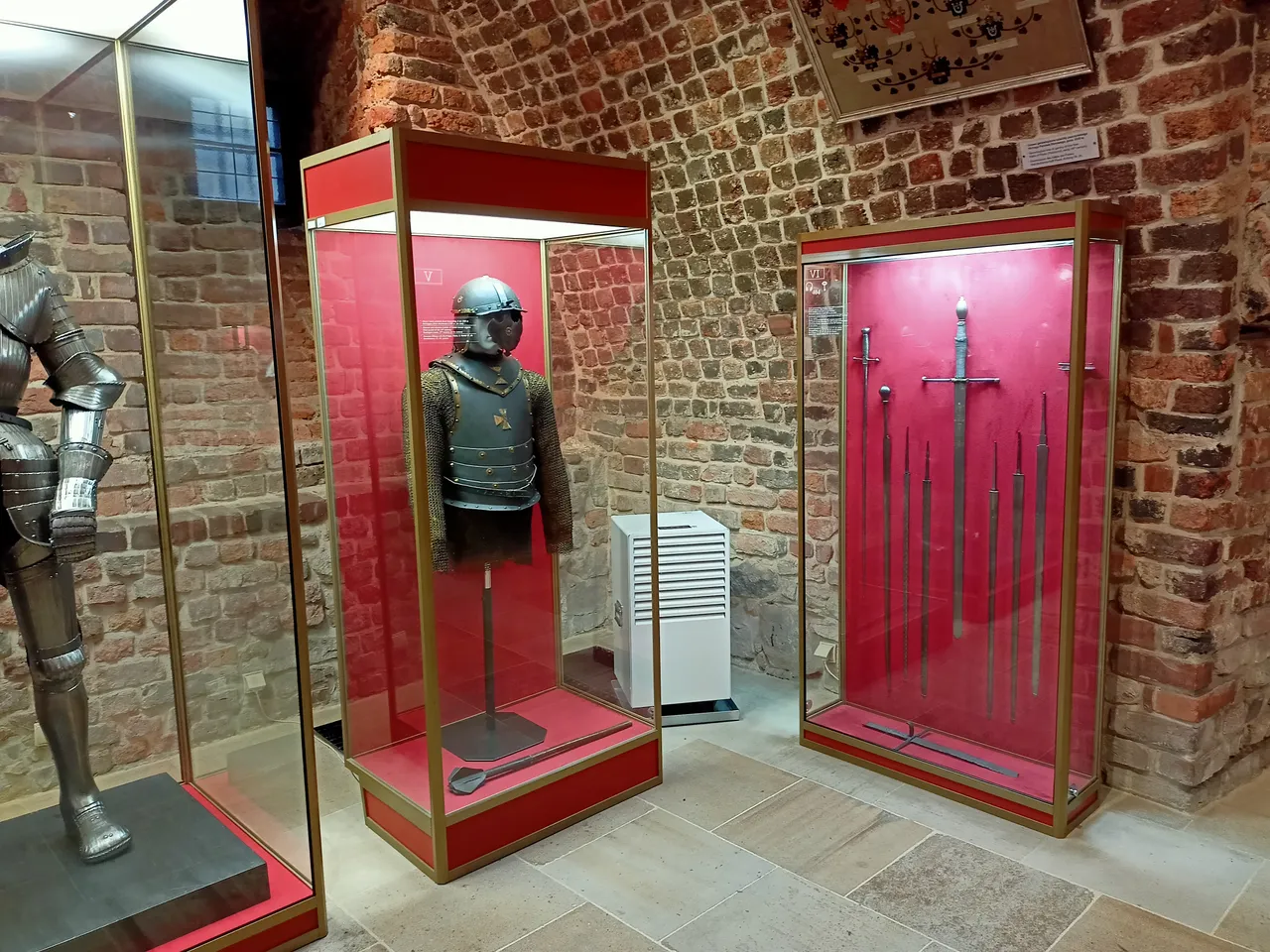 |
|---|
| Armor, swords - for hunting ? |
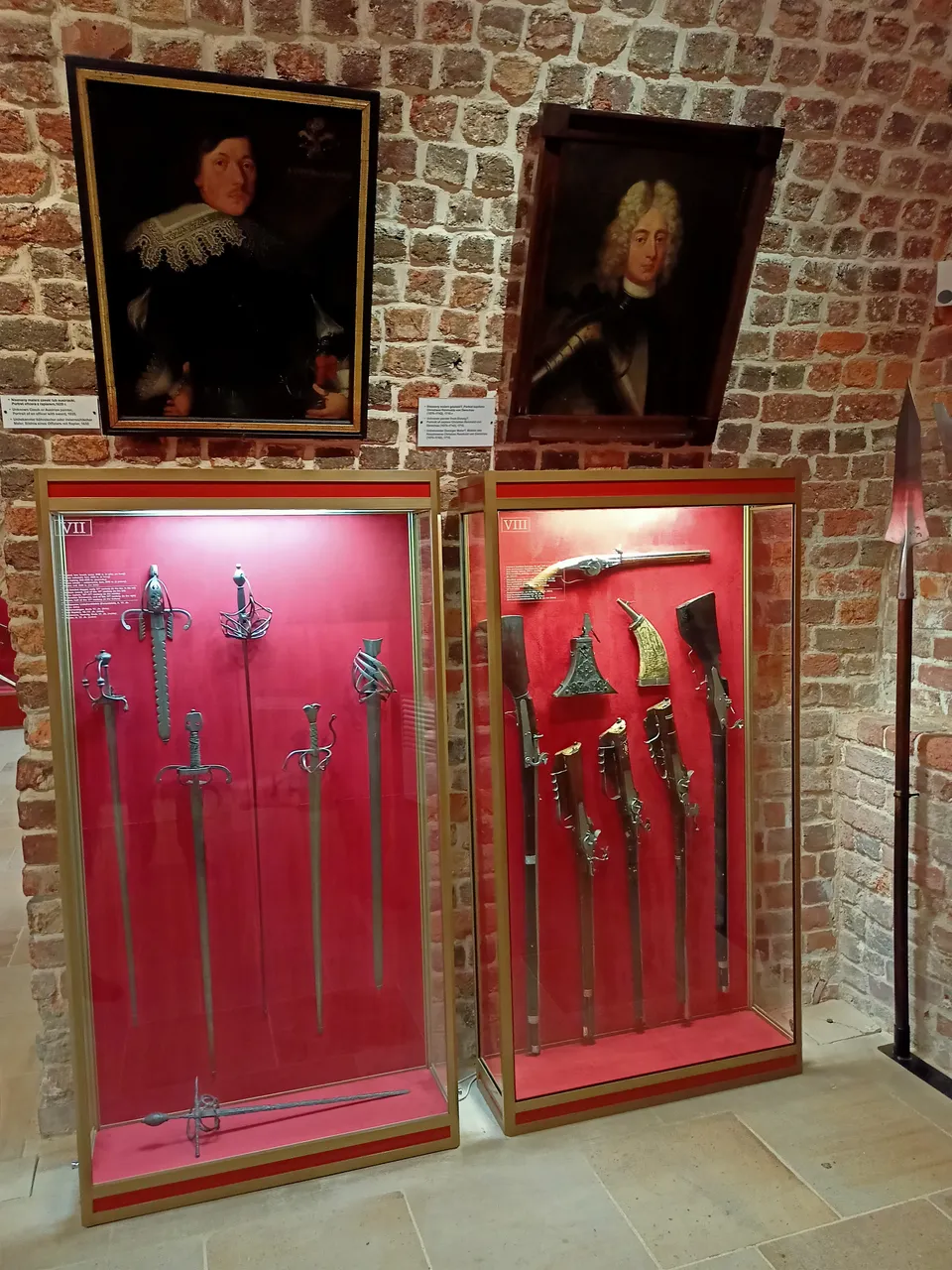 |
|---|
| Hunting rifles |
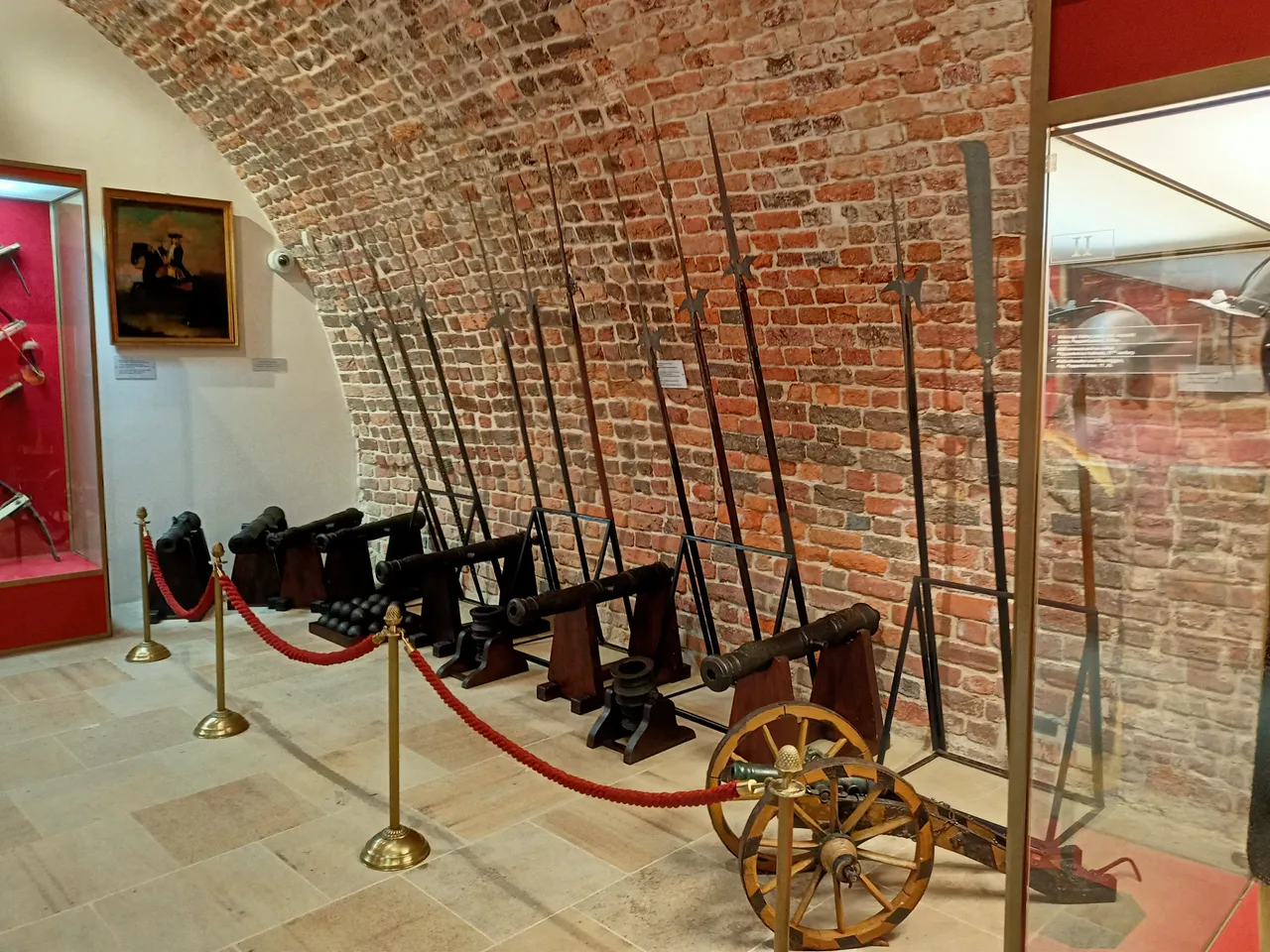 |
|---|
| Old cannons |
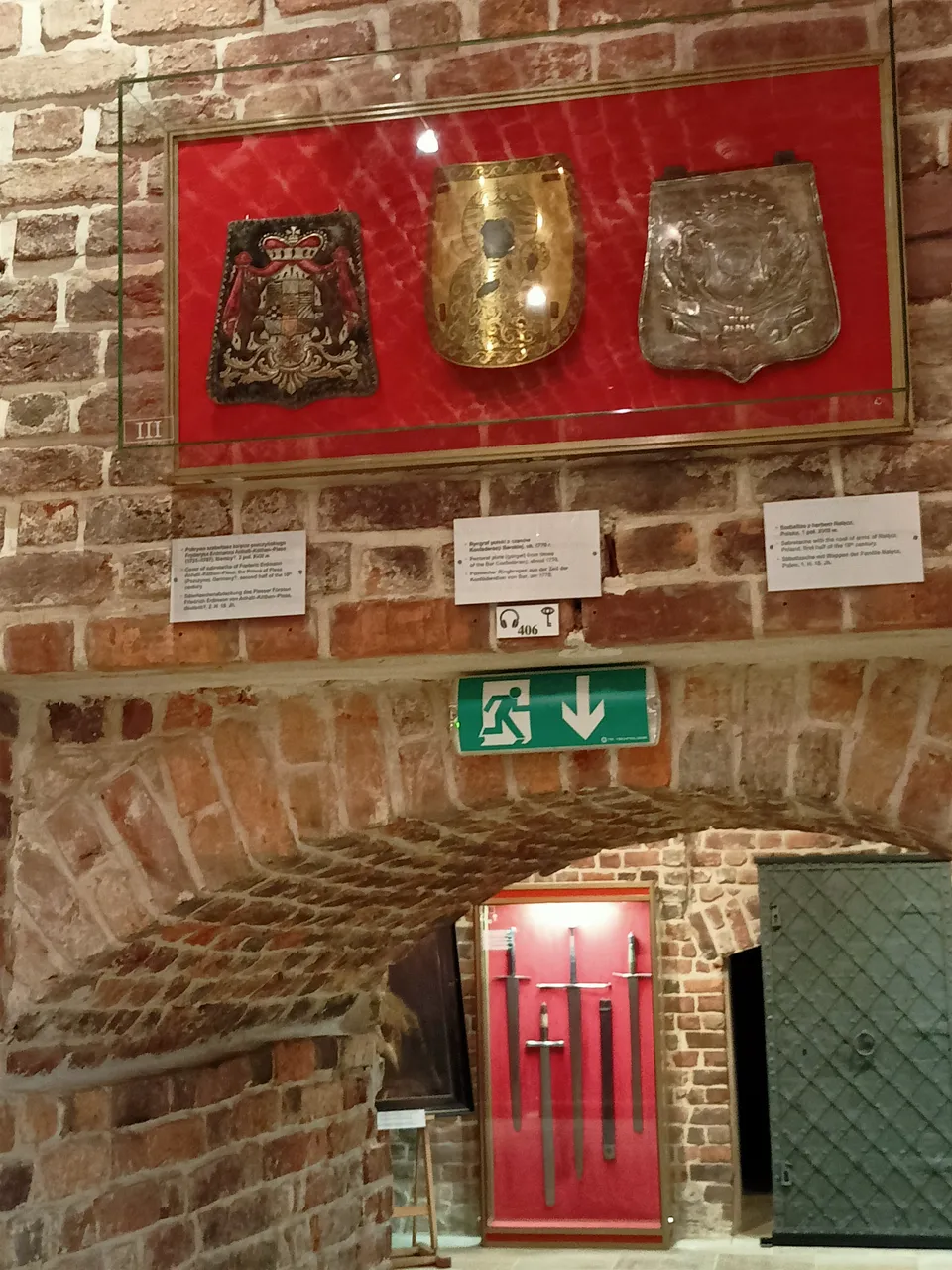
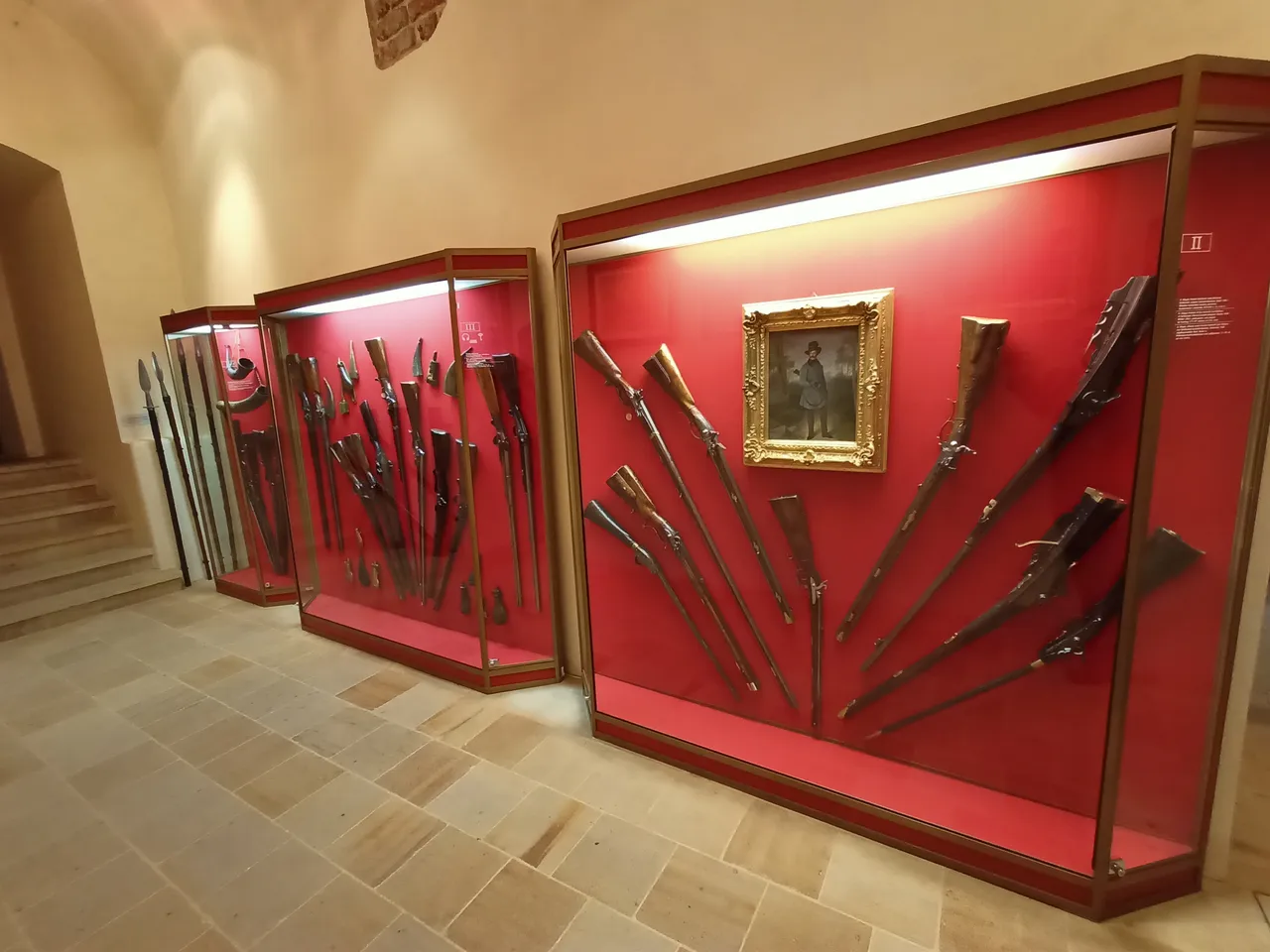 |
|---|
| Herb and example of small Table with number to Audio Guide |
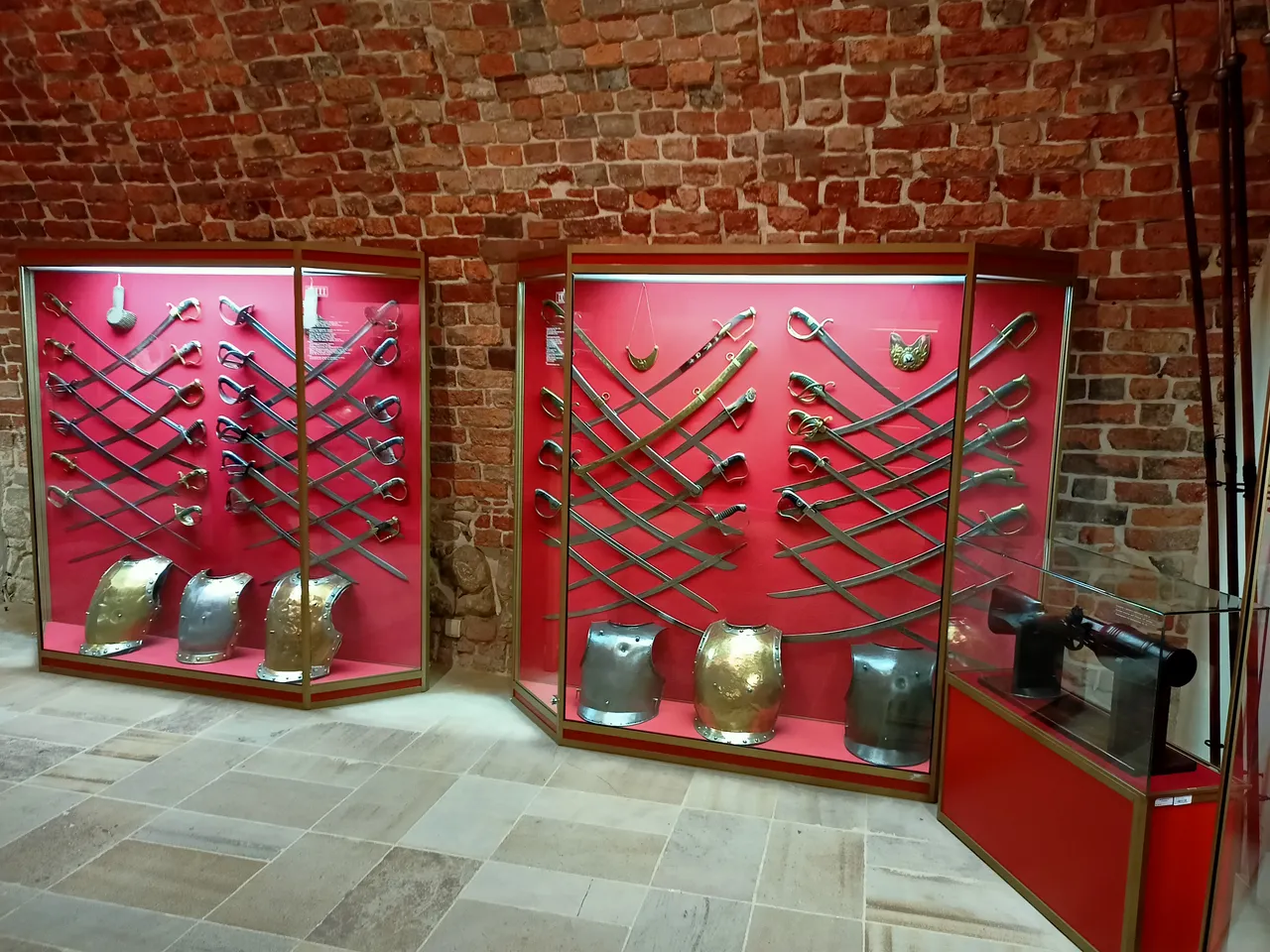 |
|---|
| More Sables |
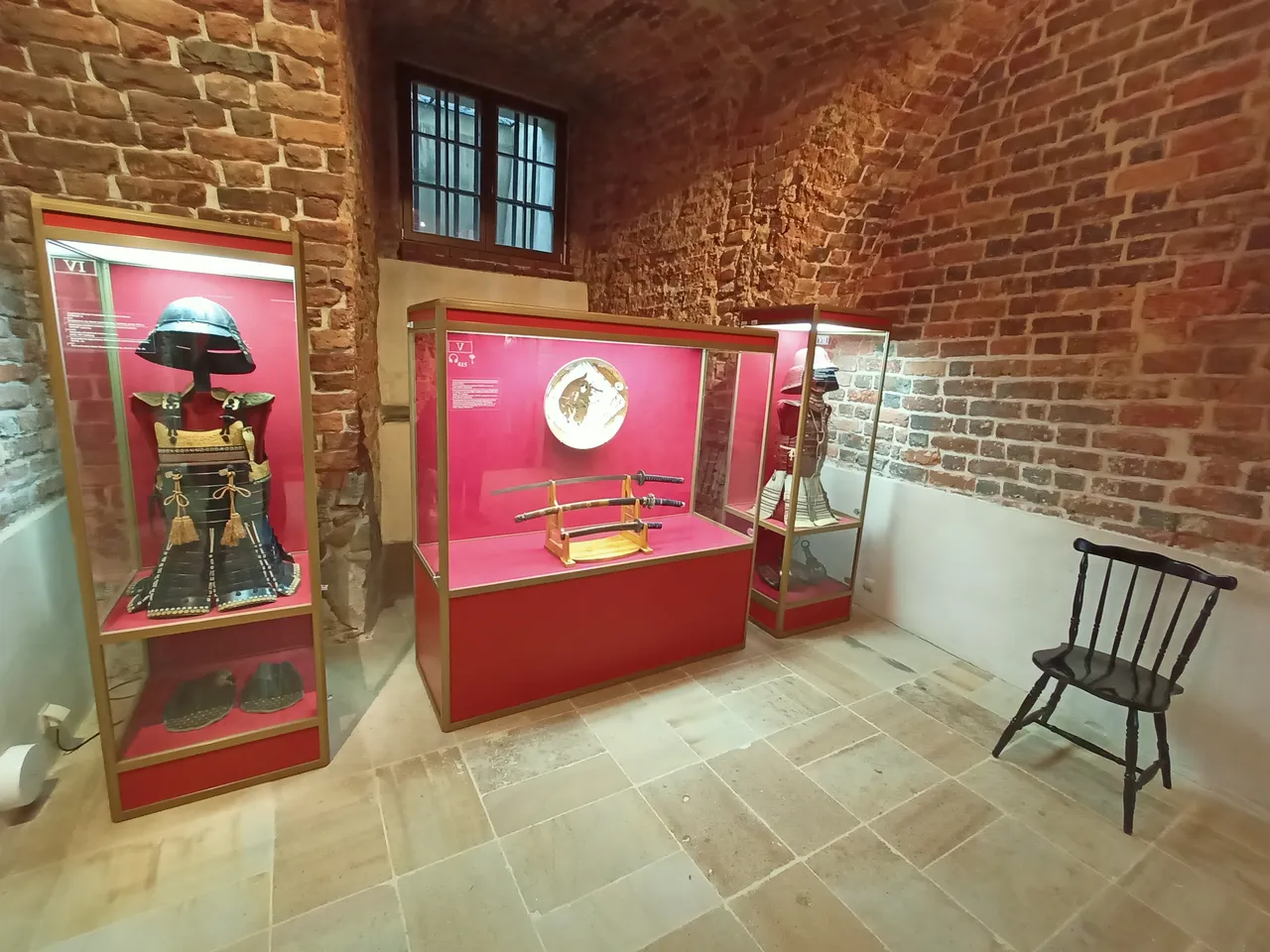 |
|---|
| SUPRISE - SAMURAI staff in German Castle |
 |
|---|
| Katana - masterpice from old times |
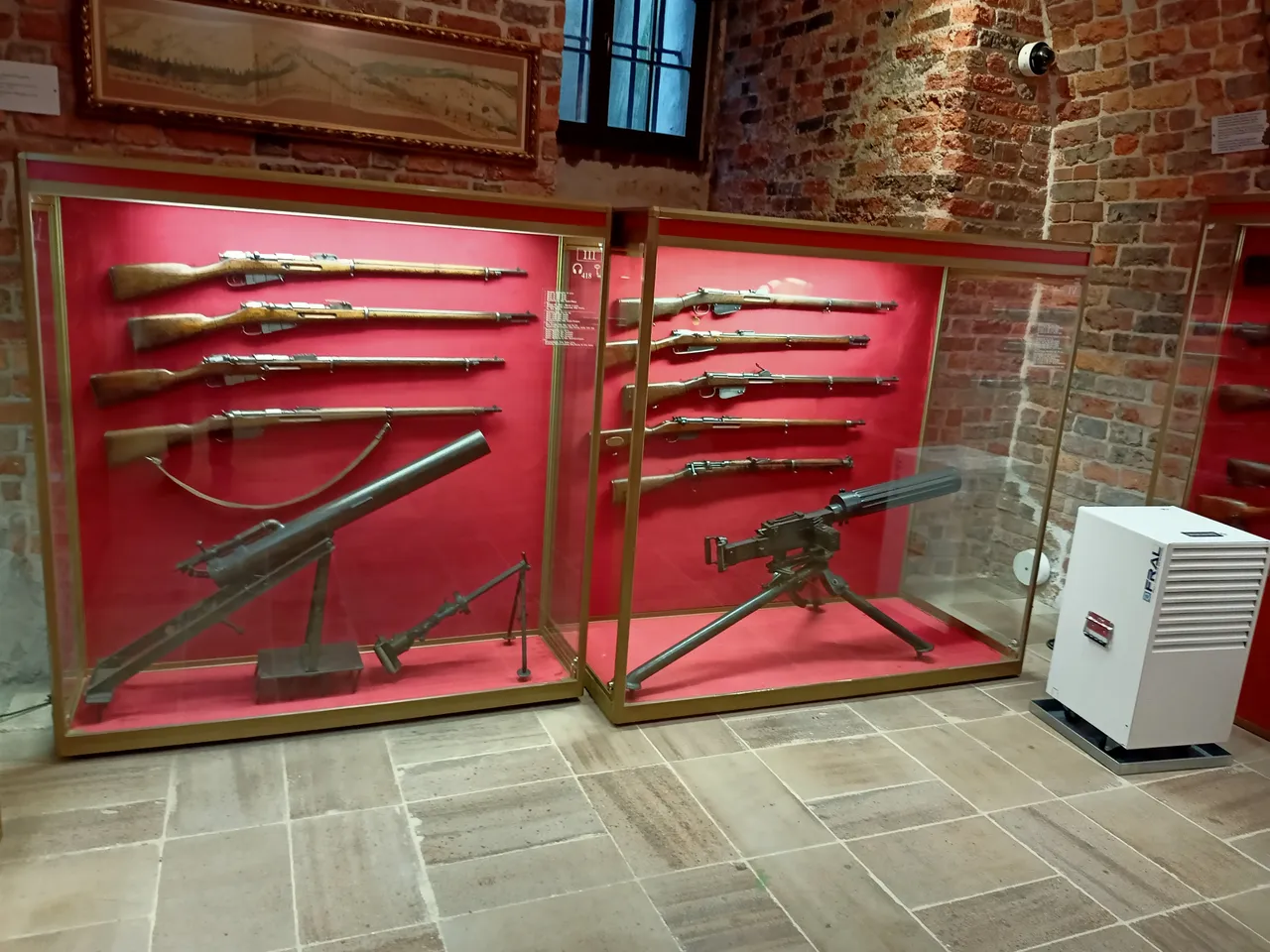 |
|---|
| Old machine guns - intersting |
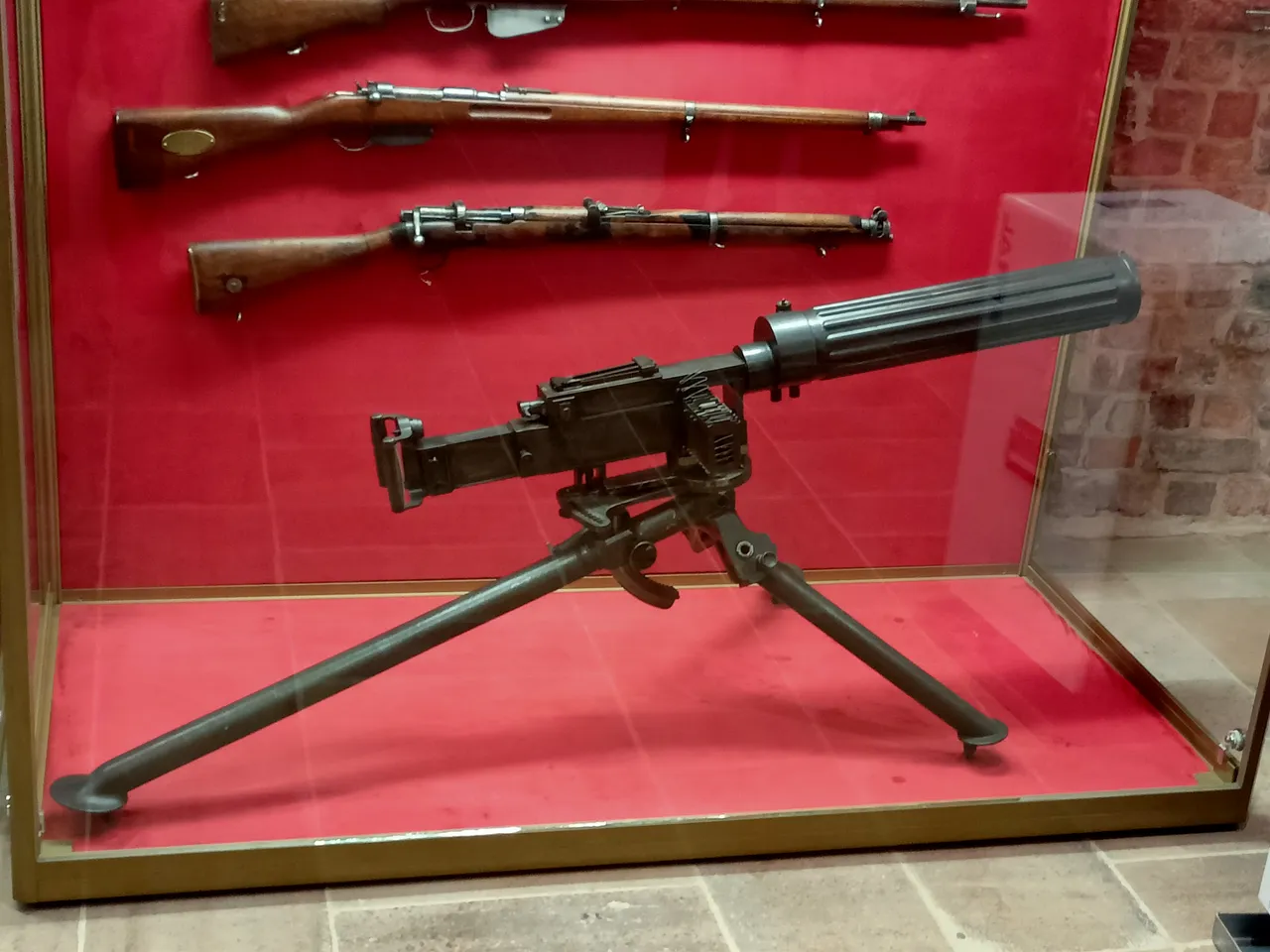 |
|---|
| Close - up = Machine Gun |
|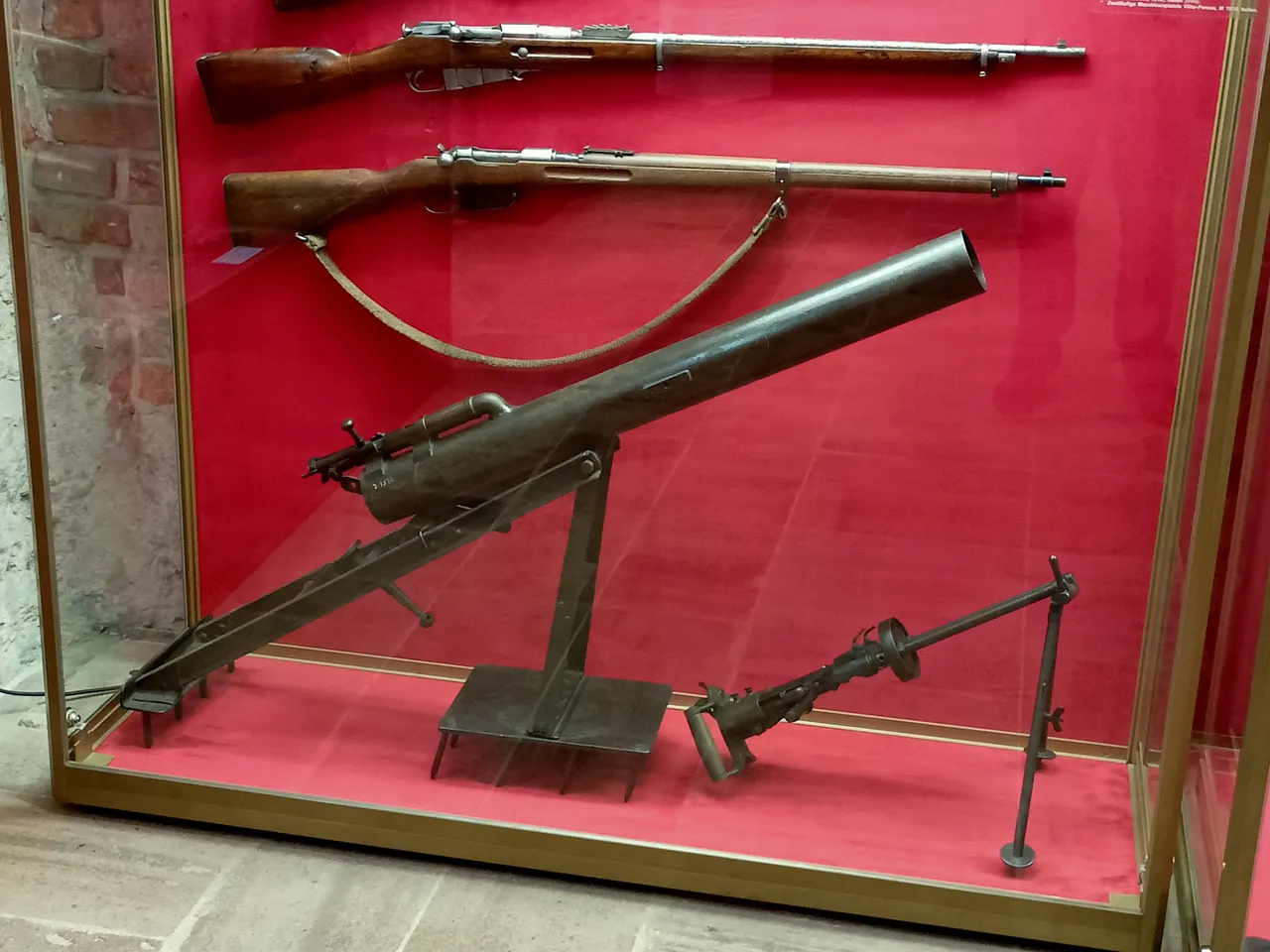 |
|
| Mortar - deadly war weapon|
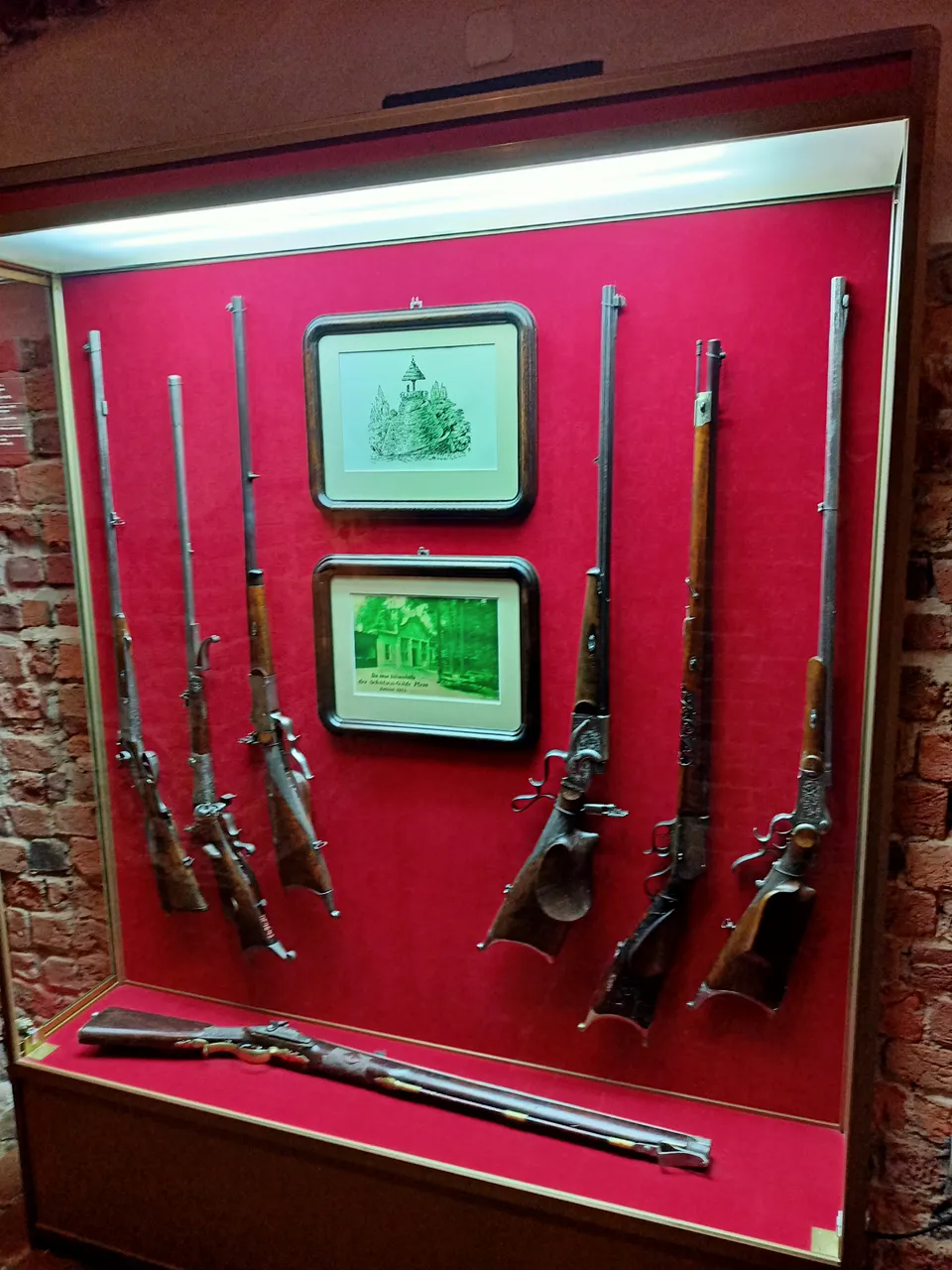 |
|---|
| Some Huting rilfes |
V. BONUS - czas coś zjeść - "Z ogórem czy bez ?"
Po męczącym i długim zwiedzaniu, człowiek staje się głodny. Zaraz przy wejściu do kompleksu zamkowego (naprzeciw bramy zwycięzców), jest mała kawiarnia. Serwują zapiekanki bardzo duże. Wymowna nazwa , bo do każdej zapiekanki dodają ogórek kiszony , albo i nie - jeśli nie chcesz. Ceny nie są wygórowane , za to co oferują. Zobaczcie zdjecia i oceńcie sami
V. BONUS - time to eat - "With or without pickle ?"
After a tiring and long sightseeing, one becomes hungry. Right at the entrance to the castle complex (opposite the winners' gate), there is a small cafe. They serve very large casseroles. The name is telling, because to each zapiekanka they add pickled cucumber, or not - if you do not want it. Prices are not exorbitant for what they offer. See photos and judge for yourself
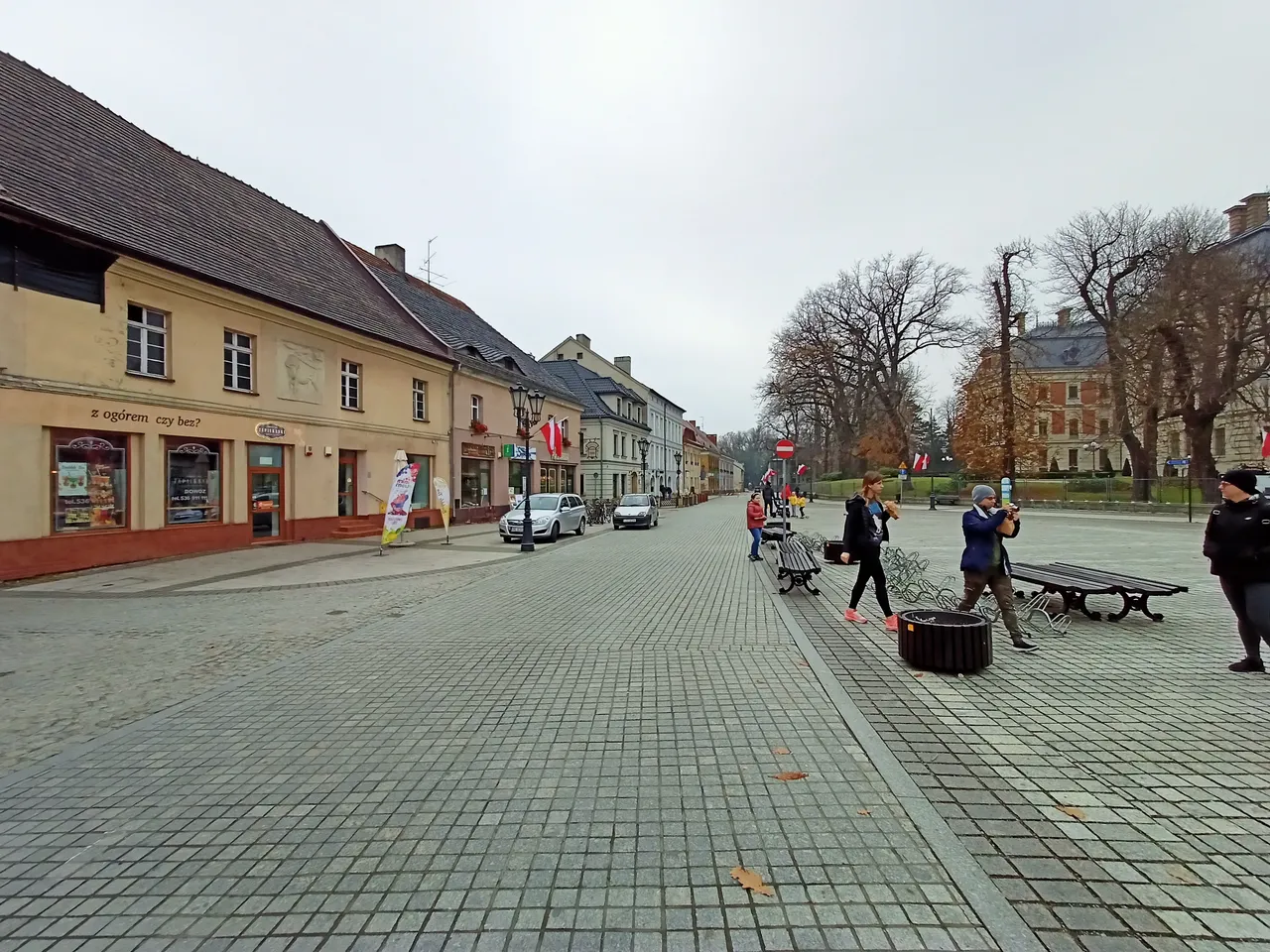 |
|---|
| The Gate to the Right . Coffe Shop to the left |
 |
|---|
| Enterance |
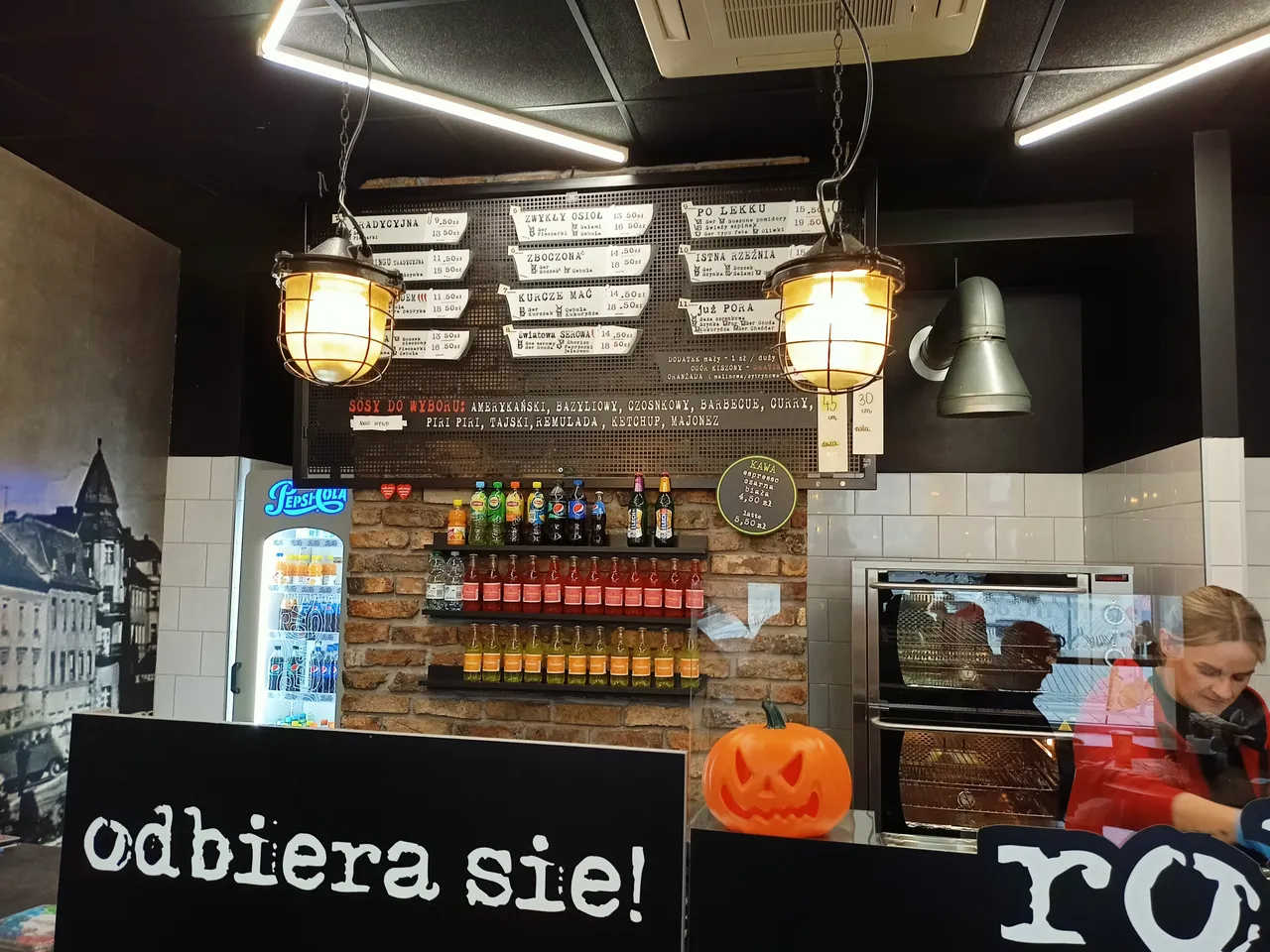 |
|---|
| Menu |
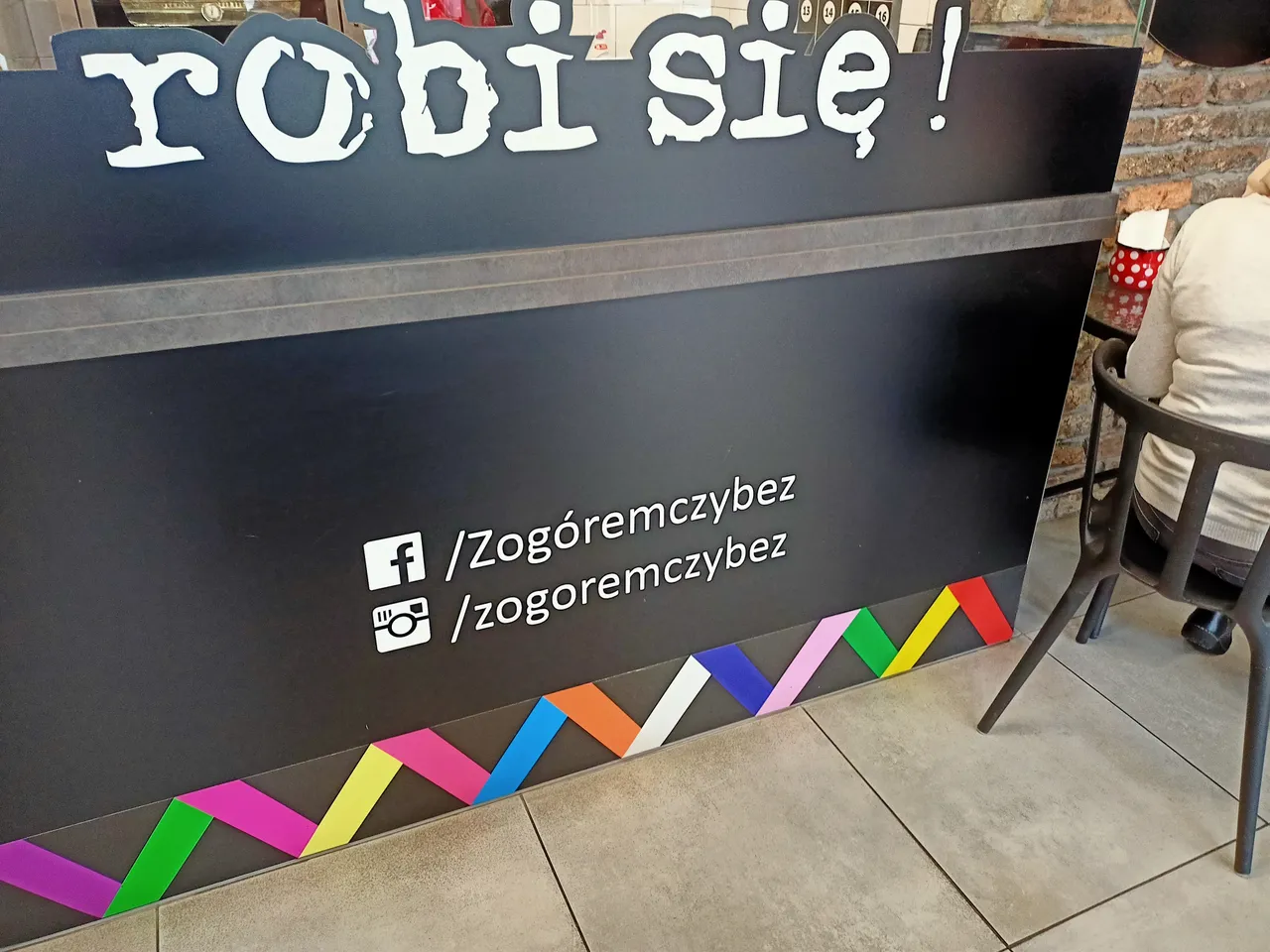 |
|---|
| FB and insta page |
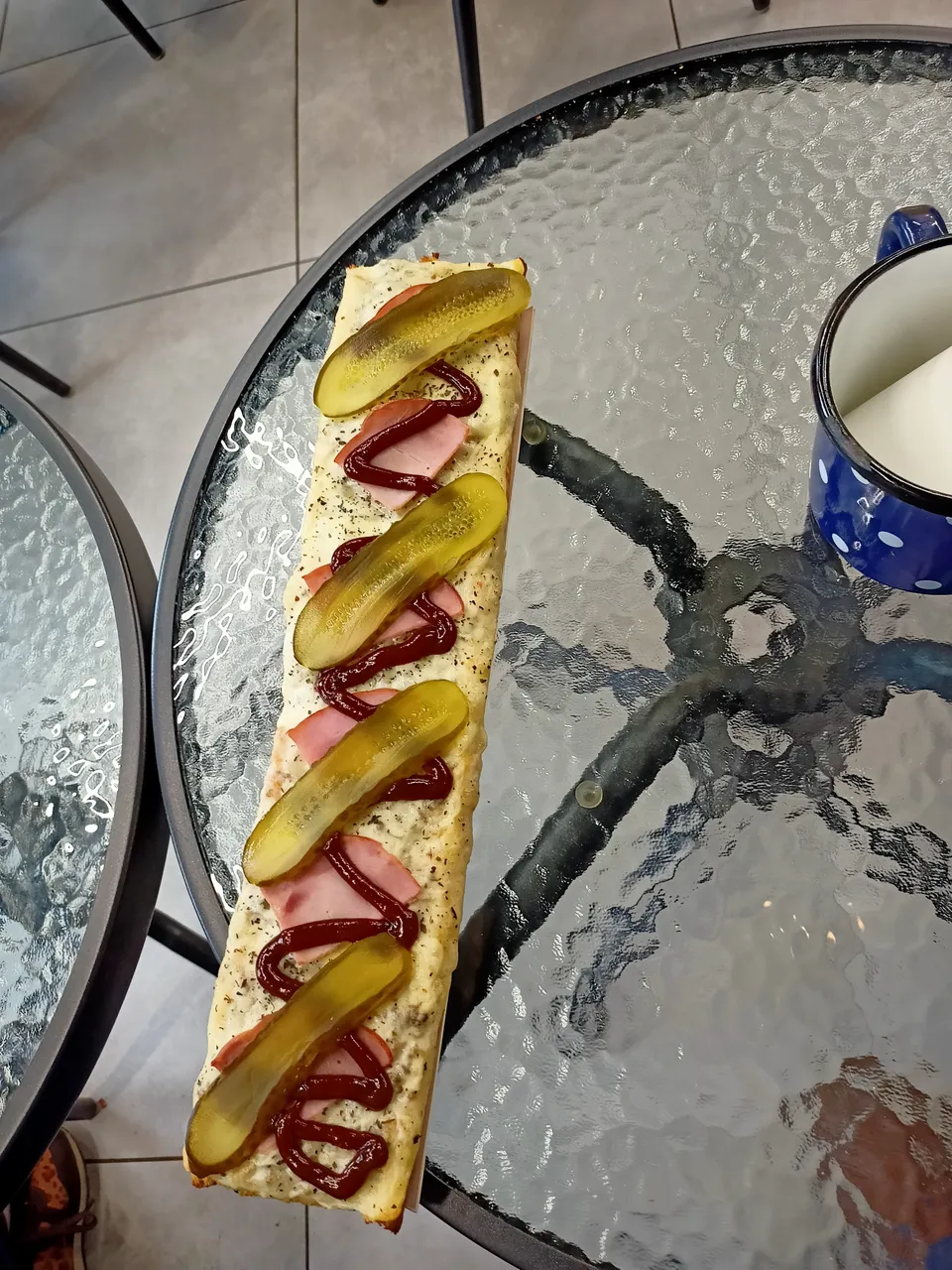 |
|---|
| Example of BIG casserole |













































 |
|




